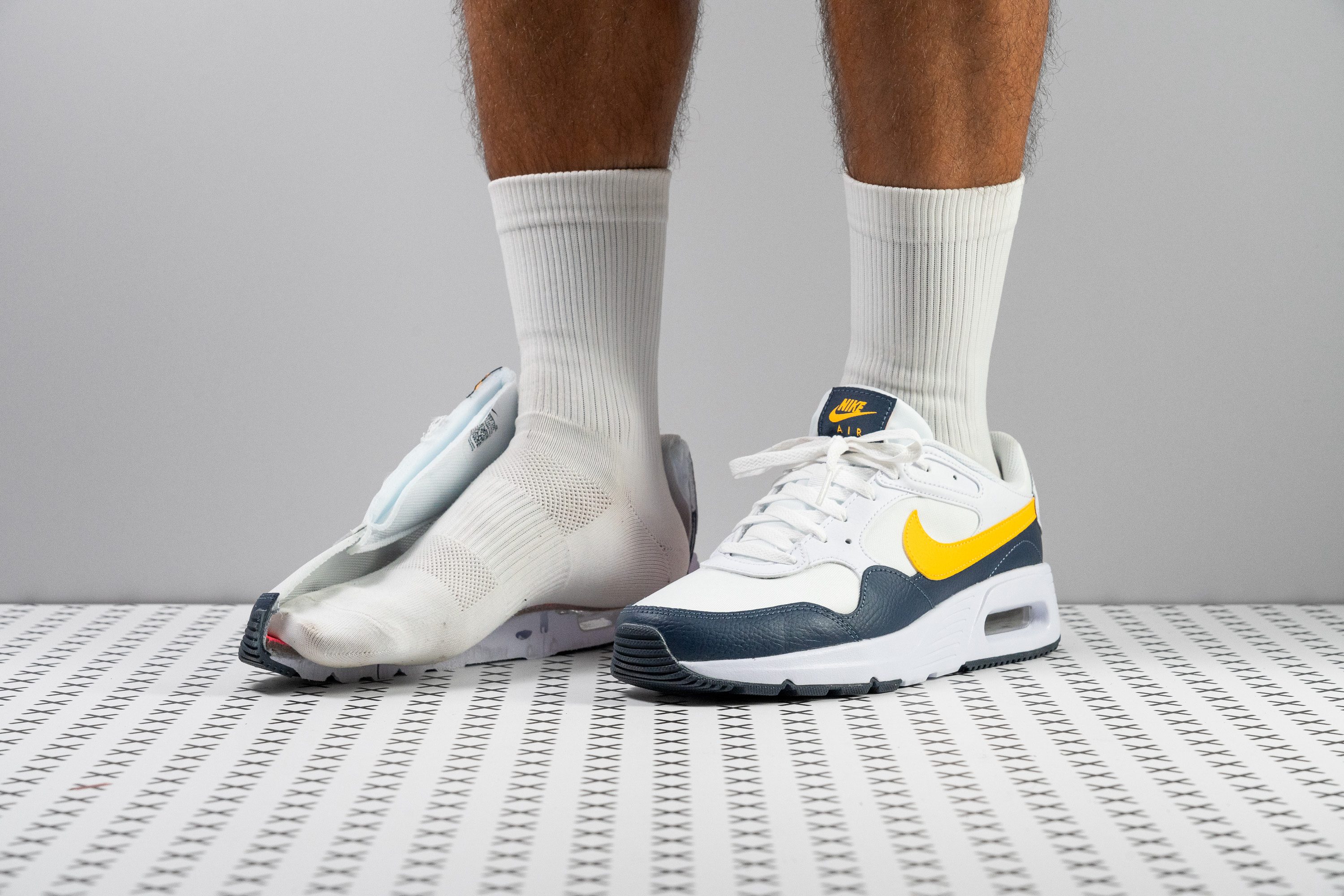Our verdict
Pros
- Super comfortable right off the bat
- Eternally fashionable
- Pretty lightweight
- Soft and big Max Air unit
- Fantastic for all-day wear
- Surprisingly breathable
- Quality materials
- Great lacing for a secure fit
- Incredibly affordable
- Good outsole grip
Cons
- Outsole lacks durability
- Not for physical activities
- Not for physical activities
Audience verdict
Comparison
The most similar trainers compared
+ + Add a shoe | |||||
|---|---|---|---|---|---|
| Audience score | 89 Good! | 91 Great! | 95 Superb! | 93 Great! | |
| Price | £80 | £80 | £85 | £75 | |
| Style | RetroSporty | ClassicRetroSporty | DadSportyChunky | Sporty | |
| Shock absorption | Moderate | - | - | High | |
| Energy return | Moderate | - | - | Moderate | |
| Traction | Moderate | - | - | High | |
| Breathability | Breathable | Warm | Breathable | Breathable | |
| Weight lab | 11.1 oz / 315g | 11.4 oz / 323g | 12.2 oz / 347g | 11.6 oz / 329g | |
| Size | True to size | True to size | True to size | True to size | |
| Midsole softness | Firm | Firm | Balanced | Firm | |
| Material | LeatherMesh | Leather | LeatherMesh | Mesh | |
| Season | SpringFall | SpringFall | Summer | Summer | |
| Inspired from | Running | Running | Running | Running | |
| Width / fit | Medium | Medium | Medium | Medium | |
| Toebox width | Medium | Narrow | Medium | Medium | |
| Leather/suede quality | - | Real leather | - | Real leather | |
| Toebox durability | Decent | Decent | Good | Decent | |
| Heel padding durability | Decent | Bad | Decent | Bad | |
| Outsole durability | Bad | Good | Good | Decent | |
| Heel stack lab | 35.8 mm | 35.7 mm | 35.3 mm | 33.1 mm | |
| Stiffness | Moderate | Stiff | Stiff | Stiff | |
| Tongue padding | Average | Average | Average | Average | |
| Drop lab | 15.6 mm | 13.6 mm | 15.0 mm | 12.7 mm | |
| Forefoot | 20.2 mm | 22.1 mm | 20.3 mm | 20.4 mm | |
| Removable insole | ✓ | ✓ | ✓ | ✓ | |
| Heel tab | None | None | None | None | |
| Torsional rigidity | Moderate | Moderate | Moderate | Moderate | |
| Heel counter stiffness | Stiff | Stiff | Moderate | Moderate | |
| Sustainable | ✗ | ✗ | ✓ | ✗ | |
| Closure | Laces | Laces | Laces | Laces | |
| Top | Low top | Low top | Low top | Low top | |
| Ranking | #88 Bottom 27% | #56 Top 47% | #6 Top 5% | #26 Top 22% | |
| Popularity | #66 Bottom 45% | #81 Bottom 33% | #103 Bottom 14% | #37 Top 31% |
Who should buy
The Nike Air Max SC should have a soft spot in your heart as well as in your wardrobe if:
- You're looking for a comfortable and lightweight pair of trainers to wear all day long.
- You want a former runner to show off in the summer that looks good with pretty much anything.
- You don't want to spend all your savings on your new shoes.
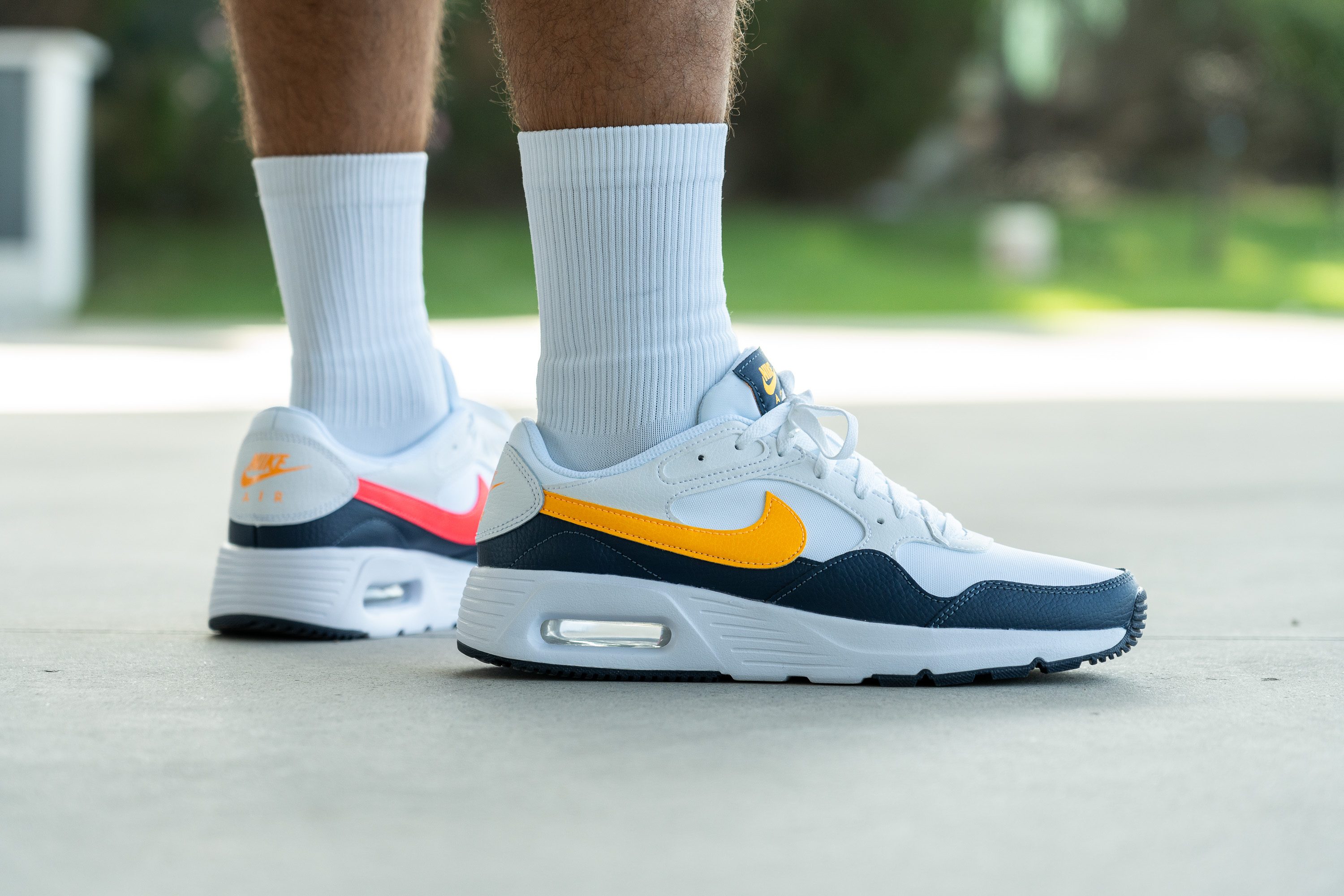
Who should NOT buy
If you want your new pair of trainers to be with you for a long time, this might not be it. Its upper and heel padding did okay on our durability tests, but its outsole got obliterated. What's more, it's not fully covered in rubber, so there's some midsole material exposed to the abrasion of the urban surfaces. With that being said, the Air Max 1 might be exactly what you're looking for! It features more durable materials and the Air Max SC is its carbon copy.
Even though this shoe has a running past, it's definitely not for running. We would definitely advise you against performing any physical activities in it, as its midsole might feel slightly unstable. If you're looking for a specific running shoe, please check our catalogue!
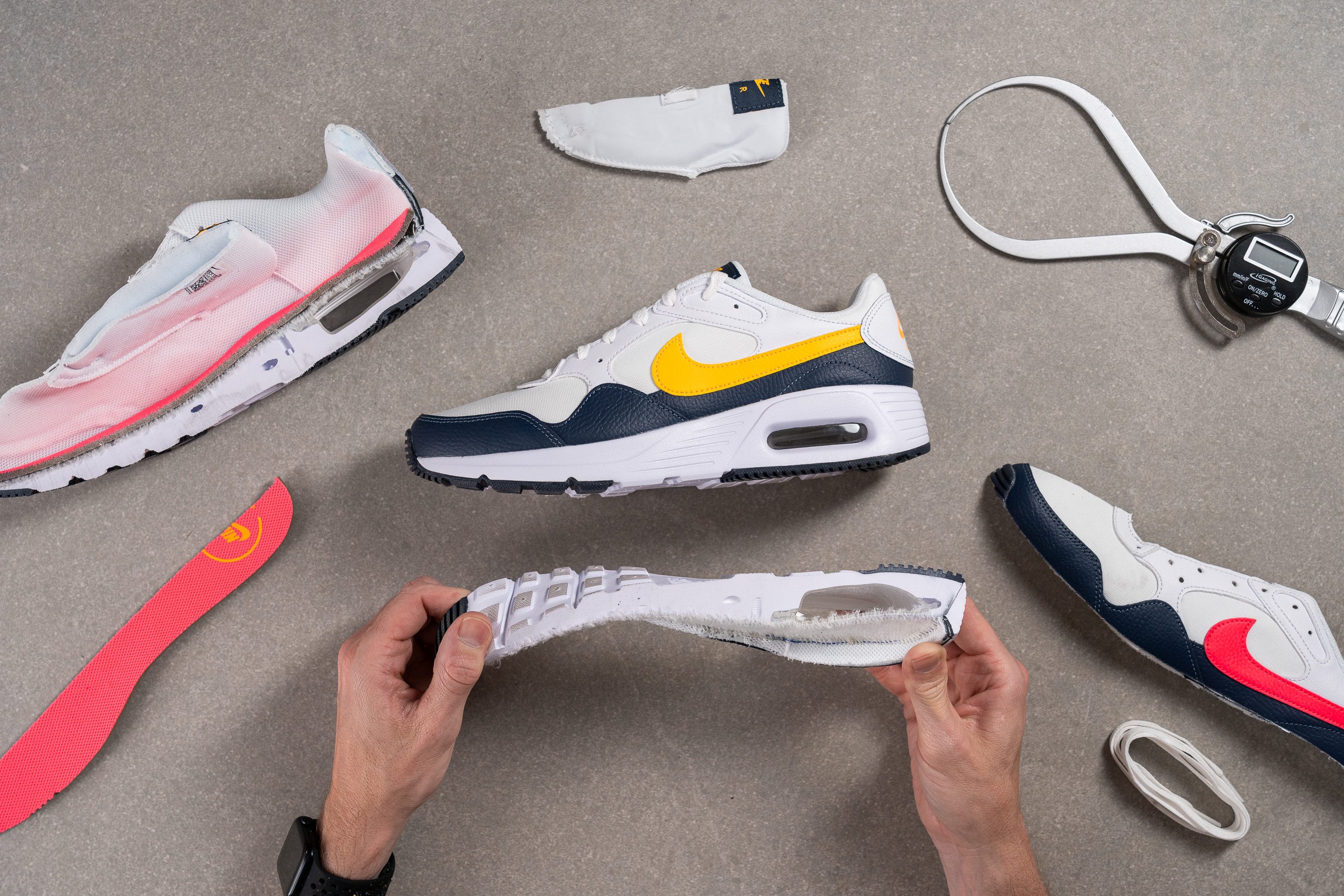
Cushioning
Shock absorption
A visible Max Air unit takes up a significant portion of the shoe's heel, adding some valuable compression in this area. It contributed to the SC's shock-absorbing properties, raising the measurement to above-average 99 SA.
While it's not the highest level of impact protection we've seen in Nike Air Max trainers, it is enough to take some load off the feet and joints if you choose to wear this Nike kick all day long.
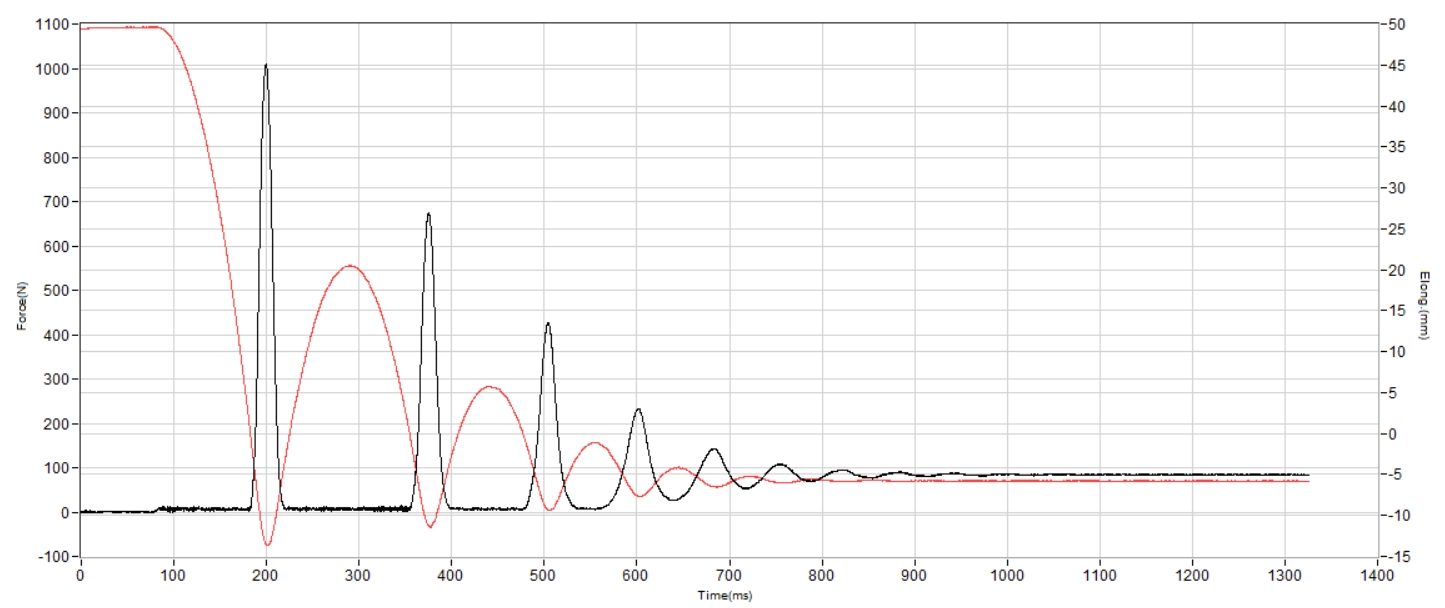
| Air Max SC | 99 SA |
| Average | 89 SA |
Energy return
As a more affordable Nike sneaker, the Air Max SC features a less advanced version of the Air technology. That also means a less bouncy underfoot experience.
With a moderate energy return of 50%, we found this shoe's responsiveness to be on par with the category average. But it's not an entirely flat ride, and it offers the benefit of a stable platform.
| Air Max SC | 50.3% |
| Average | 50.2% |
Heel stack
The massive Max Air unit at the rearfoot gave this Nike pair a heel stack of 35.8 mm.
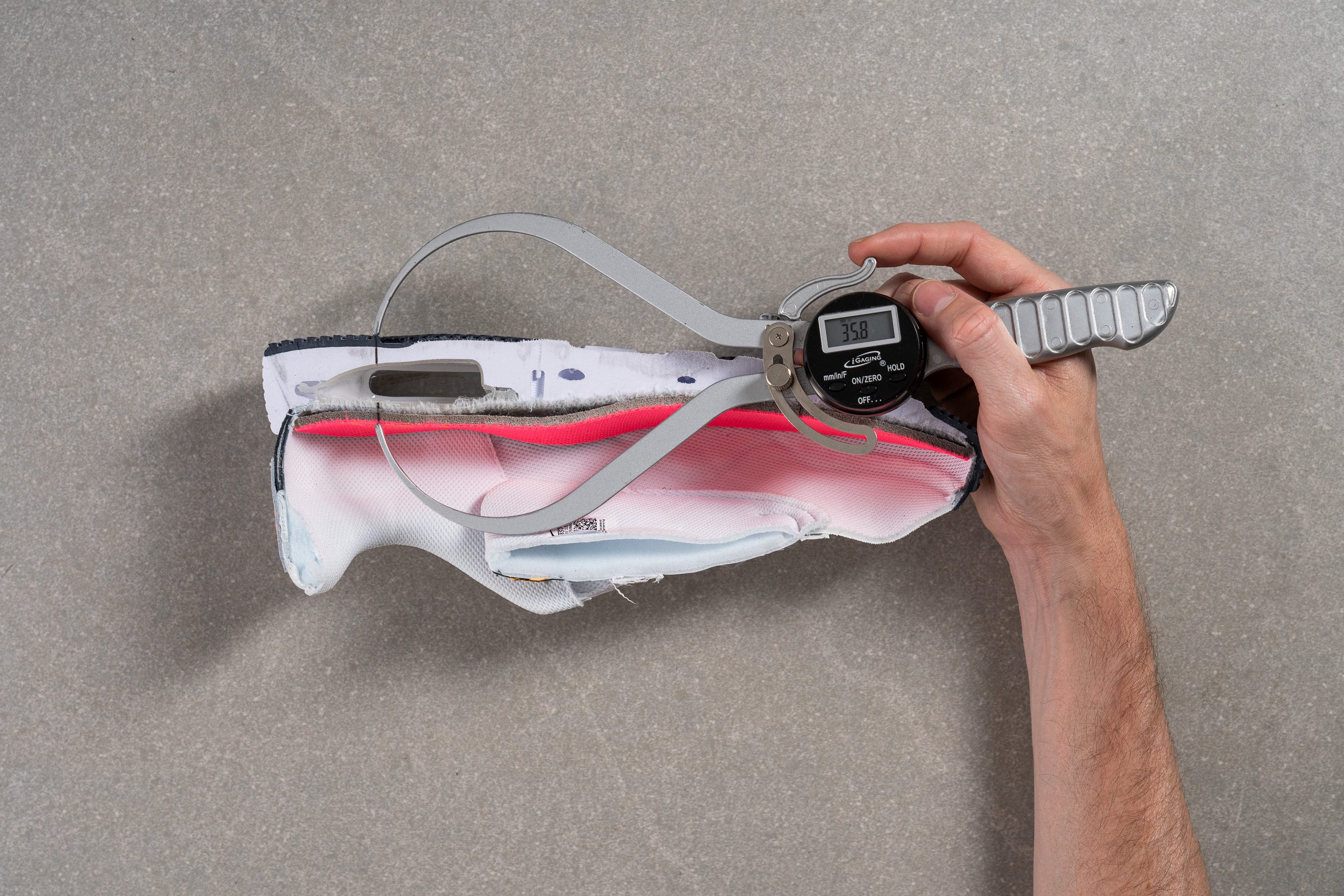
No kidding, we felt like we were walking on clouds from sunrise to sunset! Oh, how we love us some good old trainers with a fantastically designed running past.
| Air Max SC | 35.8 mm |
| Average | 30.7 mm |
Forefoot stack
One more thing that we really liked about the Air Max SC is that its forefoot stack is higher than average, which means that its heel is not the only padded part!

Our calliper returned 20.2 mm, which translated into a soft ride, happy feet, and happy us.
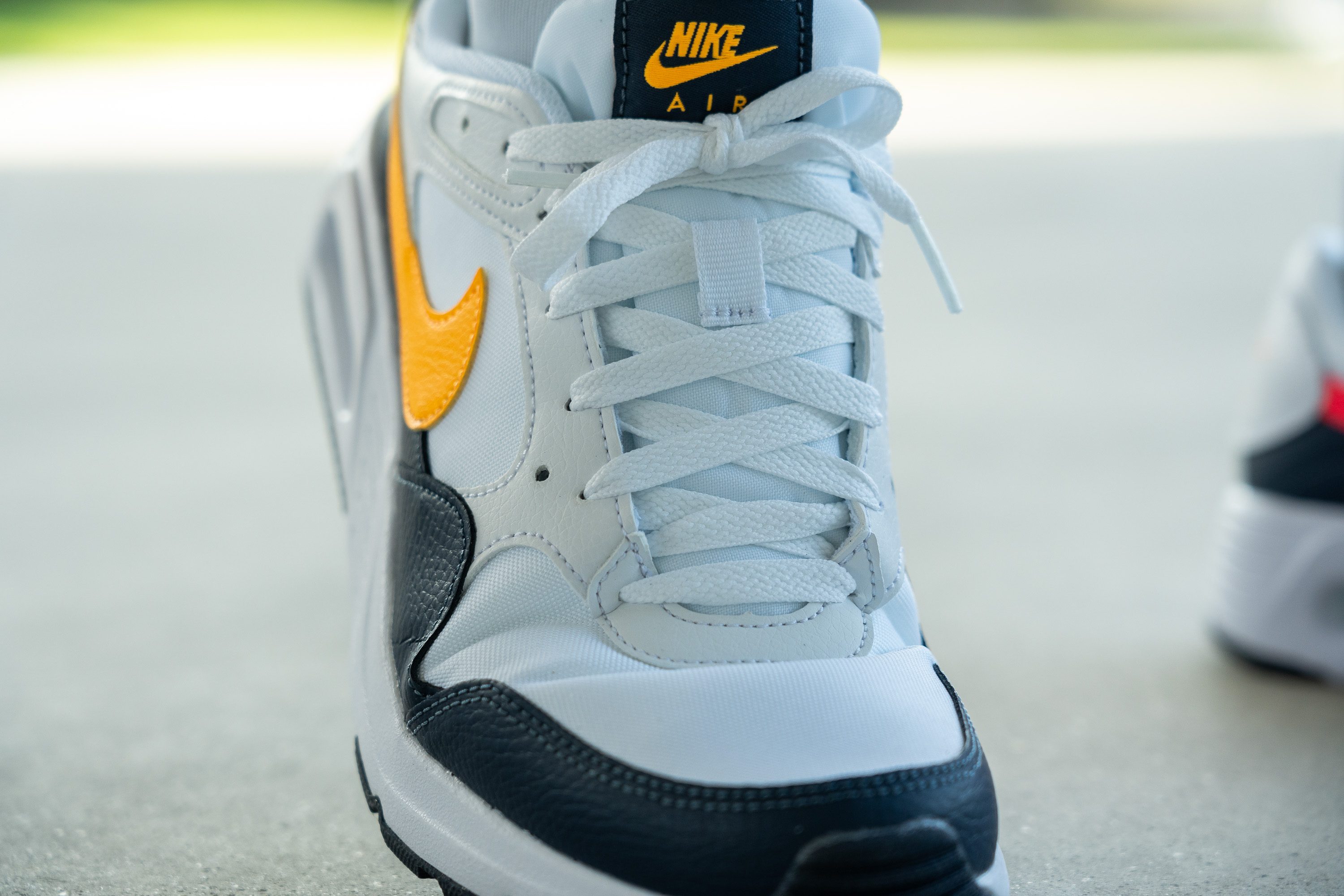
| Air Max SC | 20.2 mm |
| Average | 19.5 mm |
Drop
The gigantic Air Max unit located at the heel makes that area way higher than the ball of the foot. After measuring both, we confirmed the Air Max SC has a drop of 15.6 mm!

Even though that sounds like a lot (and it actually is a lot), don't worry, walking on this shoe was a piece of cake. We didn't have to get used to anything and it didn't feel weird at all, not even at the beginning! All we could feel was its wonderful comfort.
| Air Max SC | 15.6 mm |
| Average | 11.2 mm |
Midsole softness
As we always say, it's crucial to cut the shoes in half! Why? Well, because otherwise, you won't have full access to certain materials, like the midsole's foam.

Once we could stick our durometer in the material, it returned 33.1 HA, which means its foam is still pretty soft. This went hand in hand with our wear tests, as we enjoyed every single step with this Nike pair.
| Air Max SC | 33.1 HA |
| Average | 28.6 HA |
Size and fit
Size
Nike Air Max SC fits true to size (315 votes).
Width / Fit
We have no major concerns about the fit of the Nike Air Max SC as it feels similar to most other Swoosh trainers we tested in a D medium width.
Having created a gel mould of its interiors, we found, however, that it is slightly narrower than average in the metatarsal area (the widest part of the mould). At 90.0 mm, it is best suited for medium-to-narrow feet.
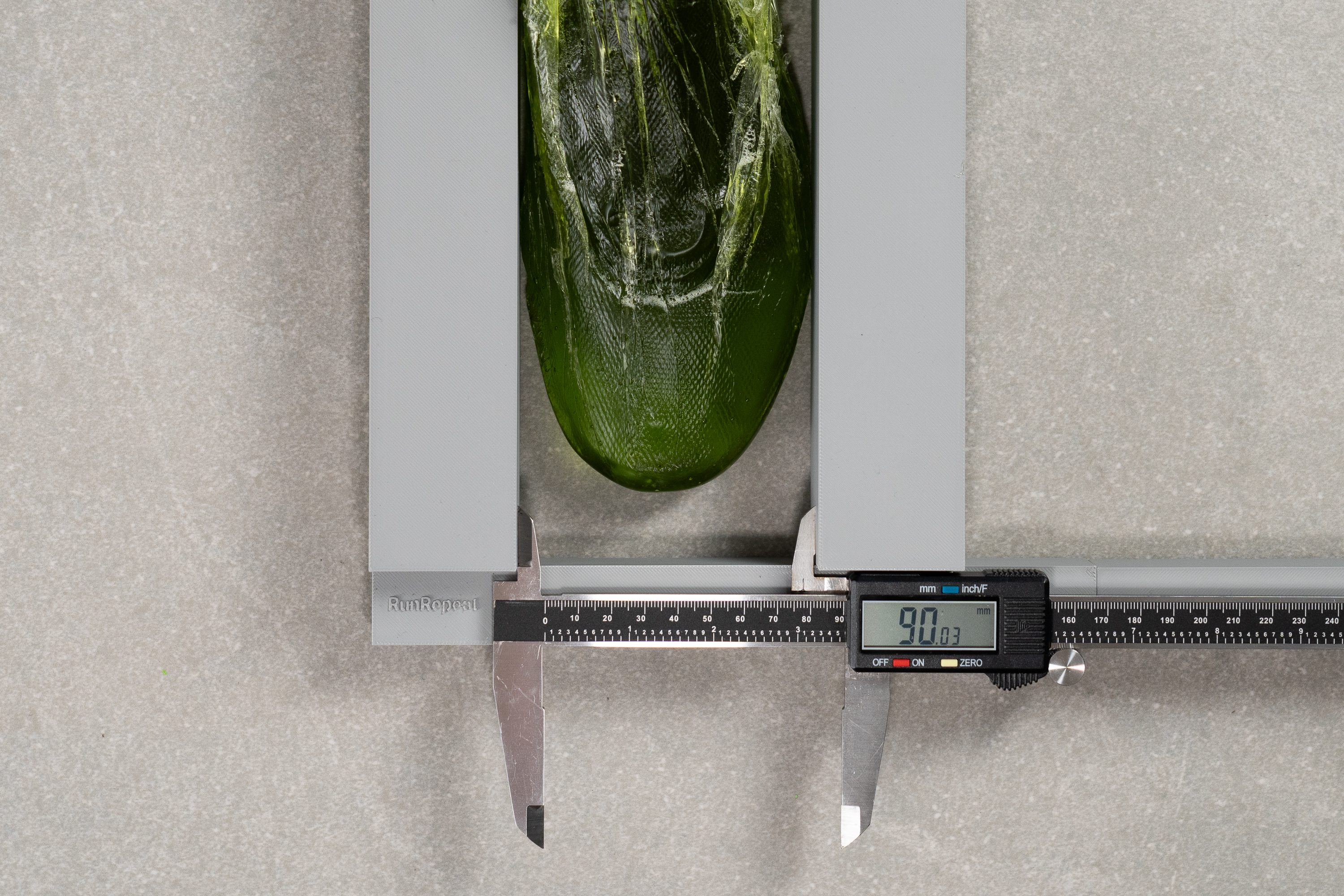
| Air Max SC | 90.0 mm |
| Average | 92.5 mm |
Toebox width
On the other hand, the shoe's toebox shape doesn't have any aggressive tapering and showed a regular width of 70.0 mm near the big toe.

| Air Max SC | 70.0 mm |
| Average | 68.9 mm |
Toebox height
It also has an ample toebox height of 28.5 mm which provides wiggle room above the toes and doesn't aggravate toe pain.
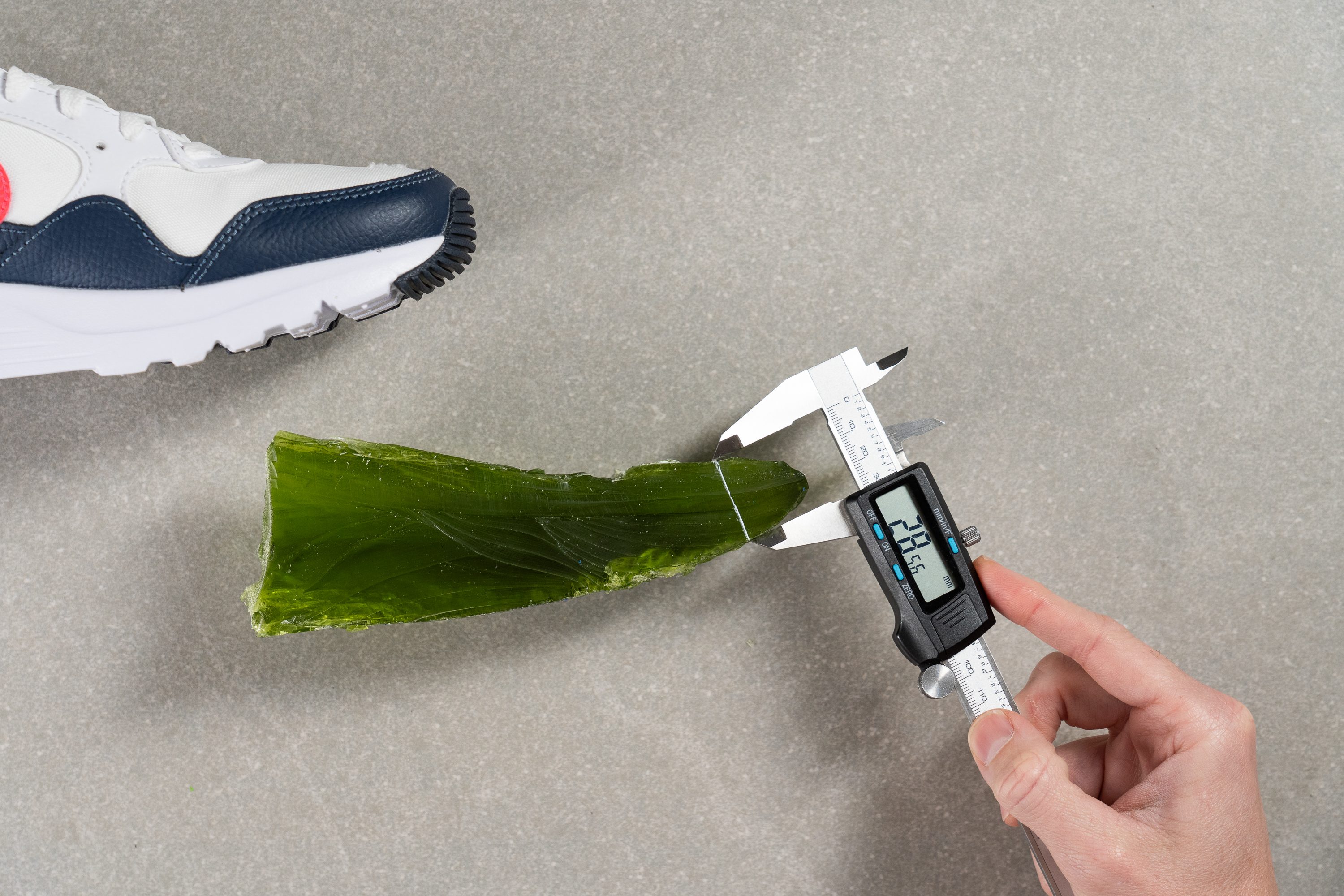
| Air Max SC | 28.5 mm |
| Average | 27.8 mm |
Traction / Grip
We found this shoe's outsole a little bit lacking, to be honest. After our analysis, we understood here's where Nike decided to save money.
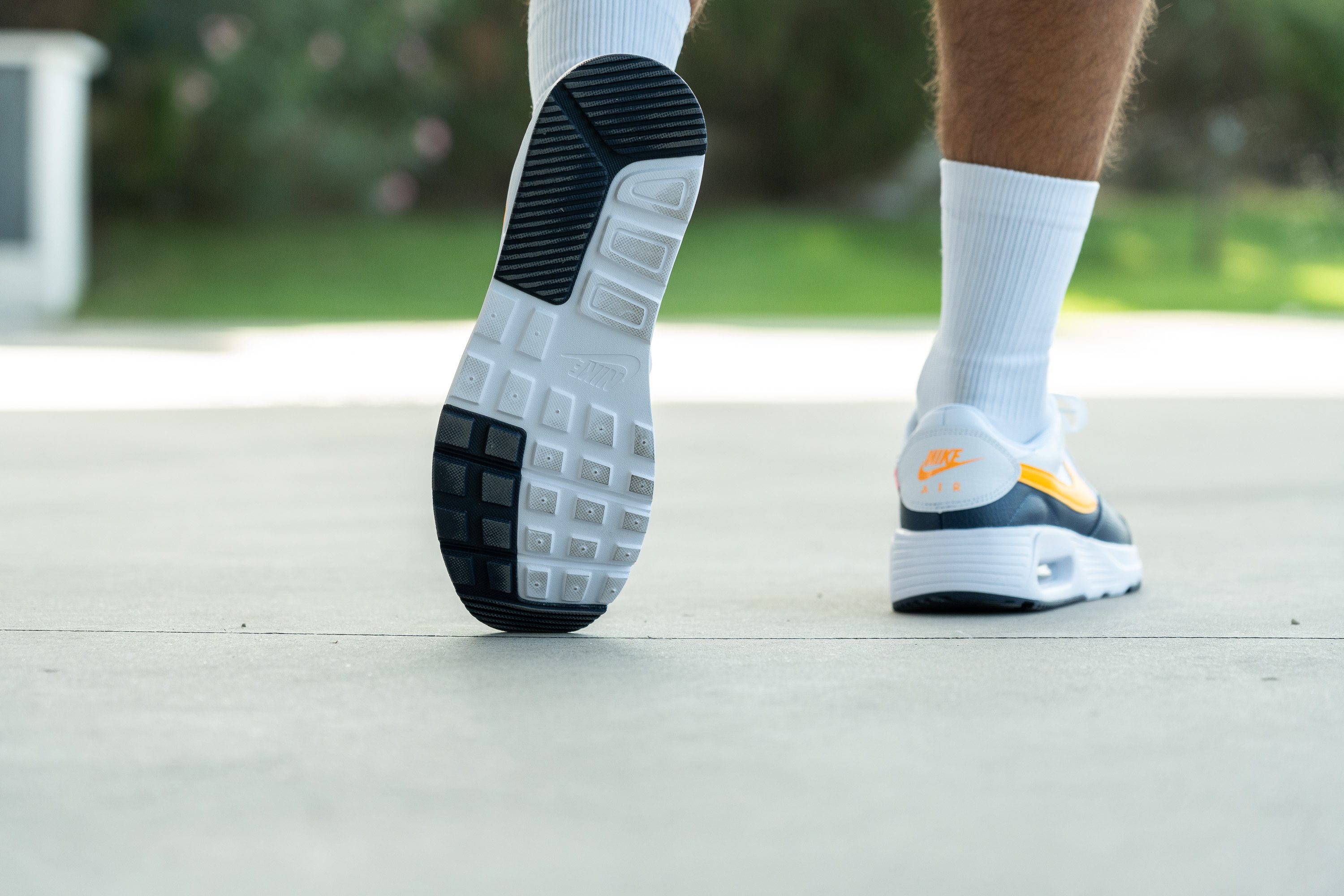
For a start, the lack of rubber coverage makes it more vulnerable to abrasion. We already checked this on our outsole durability test, but that was when we were in the lab! During our wear tests, we could also see some signs of wear and tear.
Then, this model features the iconic waffle sole by Nike, but just in the forefoot and midfoot. More towards the heel, the lugs get bigger and the rubberized area has a linear pattern. The traction was alright, but nothing crazy. Also, be careful with slippery and wet floors!
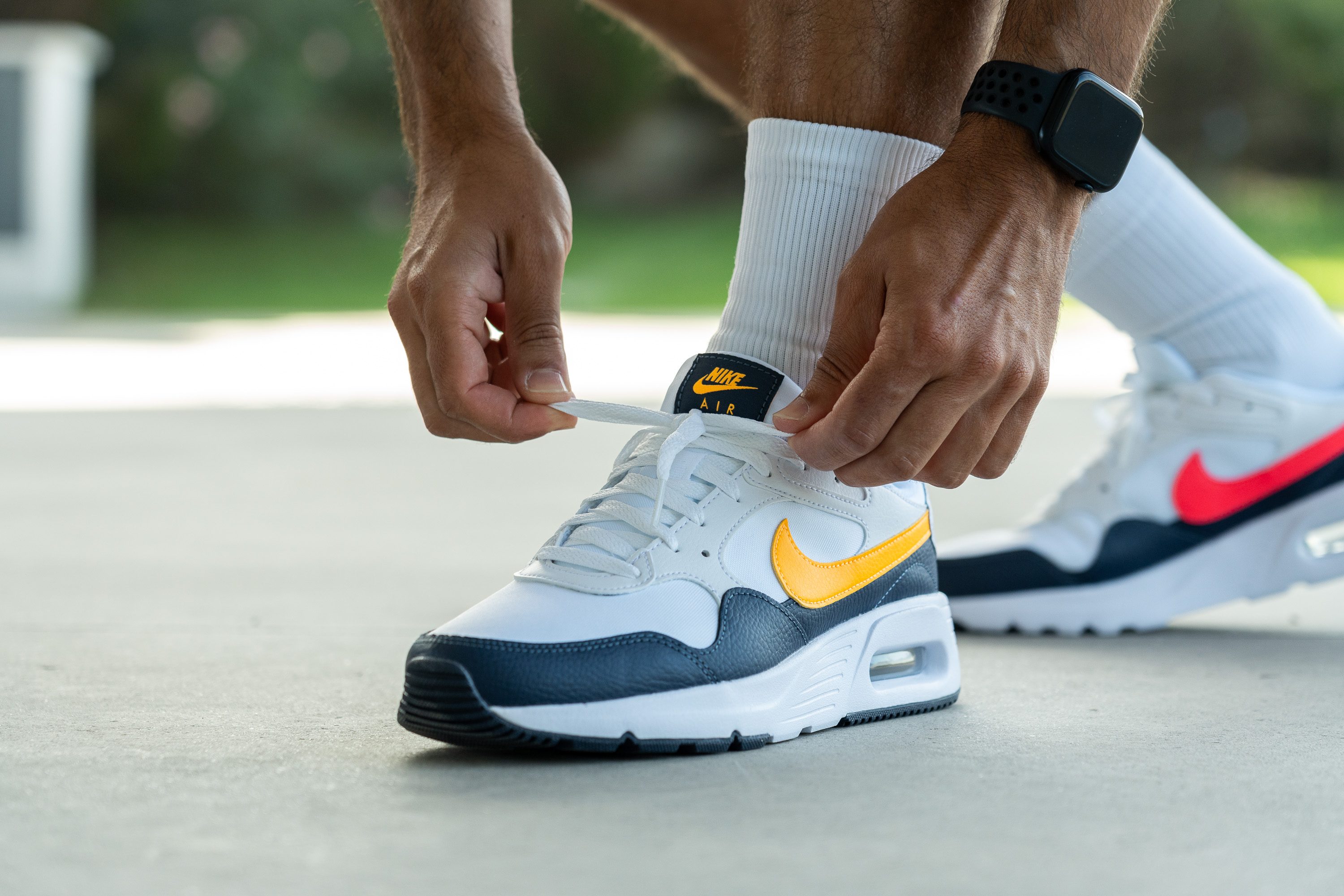
All in all, we just wished Nike would've gone for a full rubber outsole. But for 90 bucks, we really can't complain!
Traction test
We are happy to report that the Nike Air Max SC maintains great grip on dry city surfaces and is adequate on slippery ones (wet concrete, stone, wood). Recording the shoe's coefficient of friction at 0.40, we approve its bite for varied urban surfaces, from concrete sidewalks to tiled mall floors.
| Air Max SC | 0.40 |
| Average | 0.43 |
Outsole design
The waffle treading adds to the AM SC's retro vibe but we don't expect it to last very long given that it's made of exposed foam.
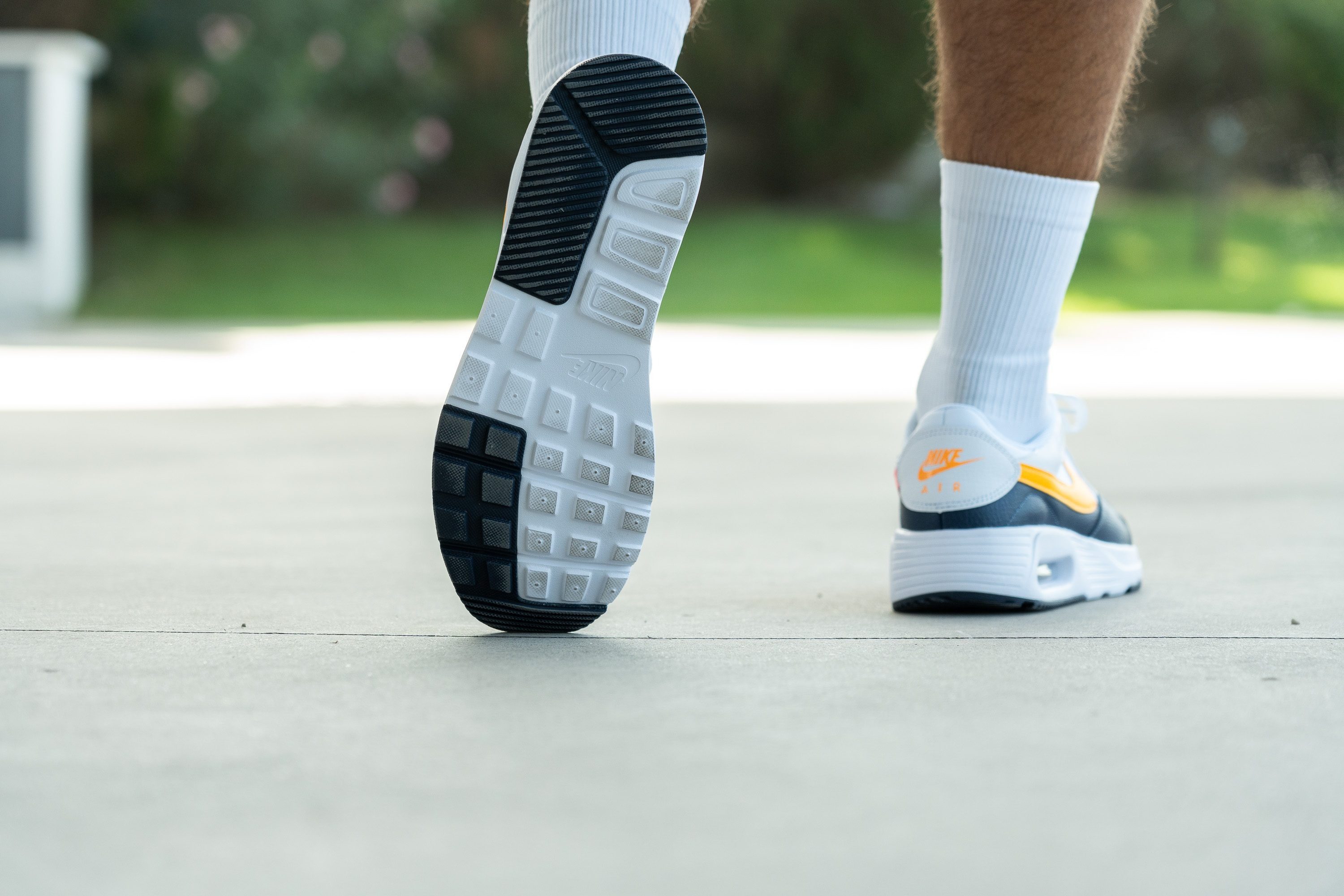
Flexibility / Stiffness
The Air Max SC felt nice, comfortable, and totally in sync with our feet. It accompanied our moves easily, readapting itself to every step.
Taking the kick through our flex test, we verified that it takes only 12.0N of force to bend by 30 degrees. This is slightly less than average and explains why it's so easy to walk in these trainers.

| Air Max SC | 12.0N |
| Average | 13.3N |
Weight
This is where this Air Max shines: it felt like a feather when we were walking around town! During our wear tests, we enjoyed the breathable and lightweight materials of this pair. All this added extra points to its already very comfortable structure, and we loved it!
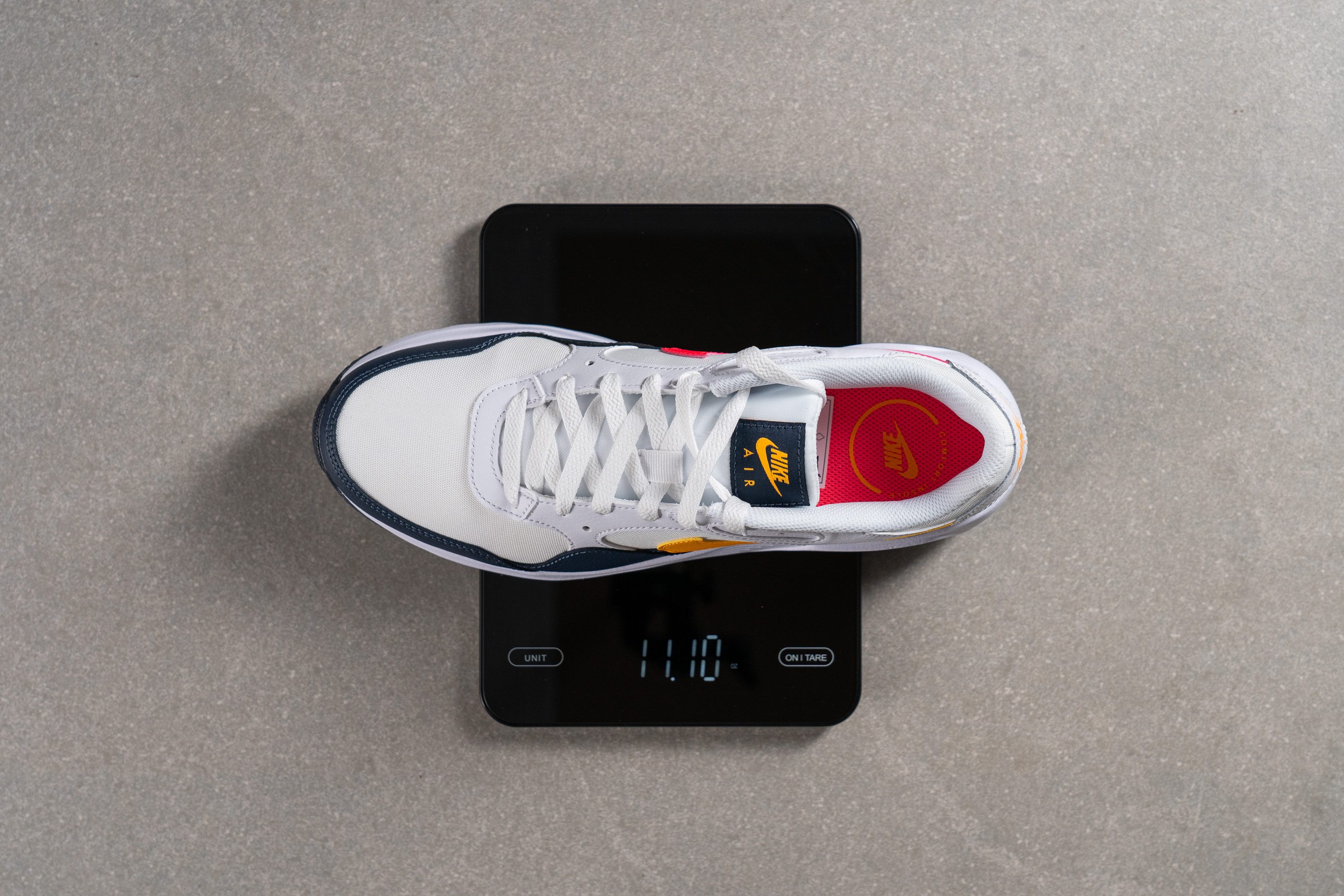
At 11.10 oz/315g, our scale confirmed it! We could walk around town, go out with friends, and even run errands all day long with these pretty pals.
| Air Max SC | 11.1 oz (315g) |
| Average | 13.8 oz (390g) |
Breathability
Walking around town with this shoe felt like a breeze, but when we took it out of the box... we were not that sure.
When we put a piece of the upper (cause yeah, we do cut every single shoe here in RunRepeat) in front of our light in the lab, we couldn't see any ventilation holes. We saw the light shining a bit through the material, though, but that was pretty much it!
So we decided to test with our smoke machine to see if the materials let the air go out.
It didn't look like it would be very breathable at the beginning, but we've done this a thousand times, so we knew we had to wait patiently. After a couple more seconds, we saw the smoke slowly come out of the shoe.
Yeah, we know we can't compare it with the Adidas Astir. Those kicks were definitely a train in their past life! However, the constant flow of smoke throughout more than one area in the Air Max SC has made us give it a 4/5 on our breathability test.
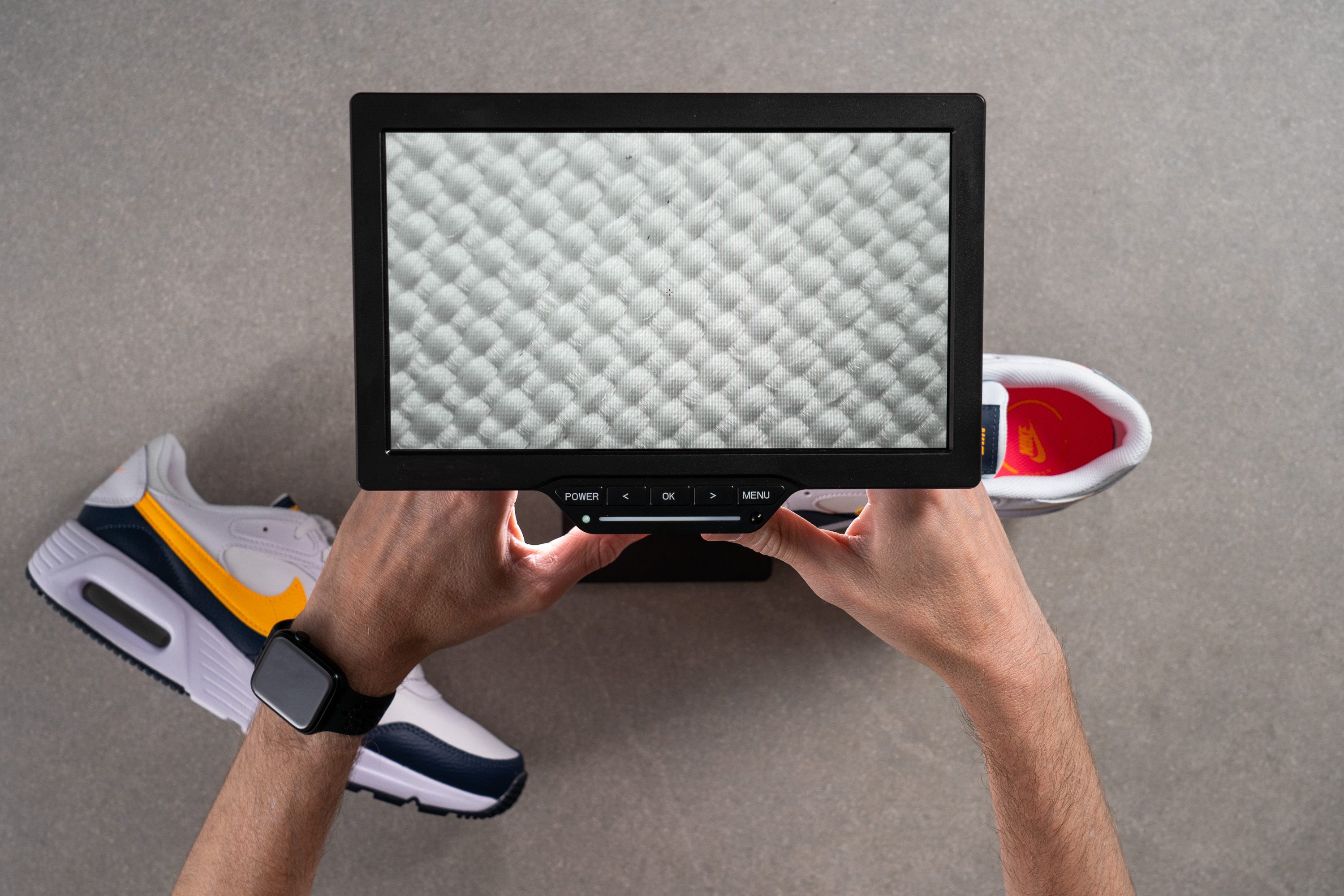
This is what its mesh looks like. As you can see, there are no ventilation holes or any kind of gaps around.
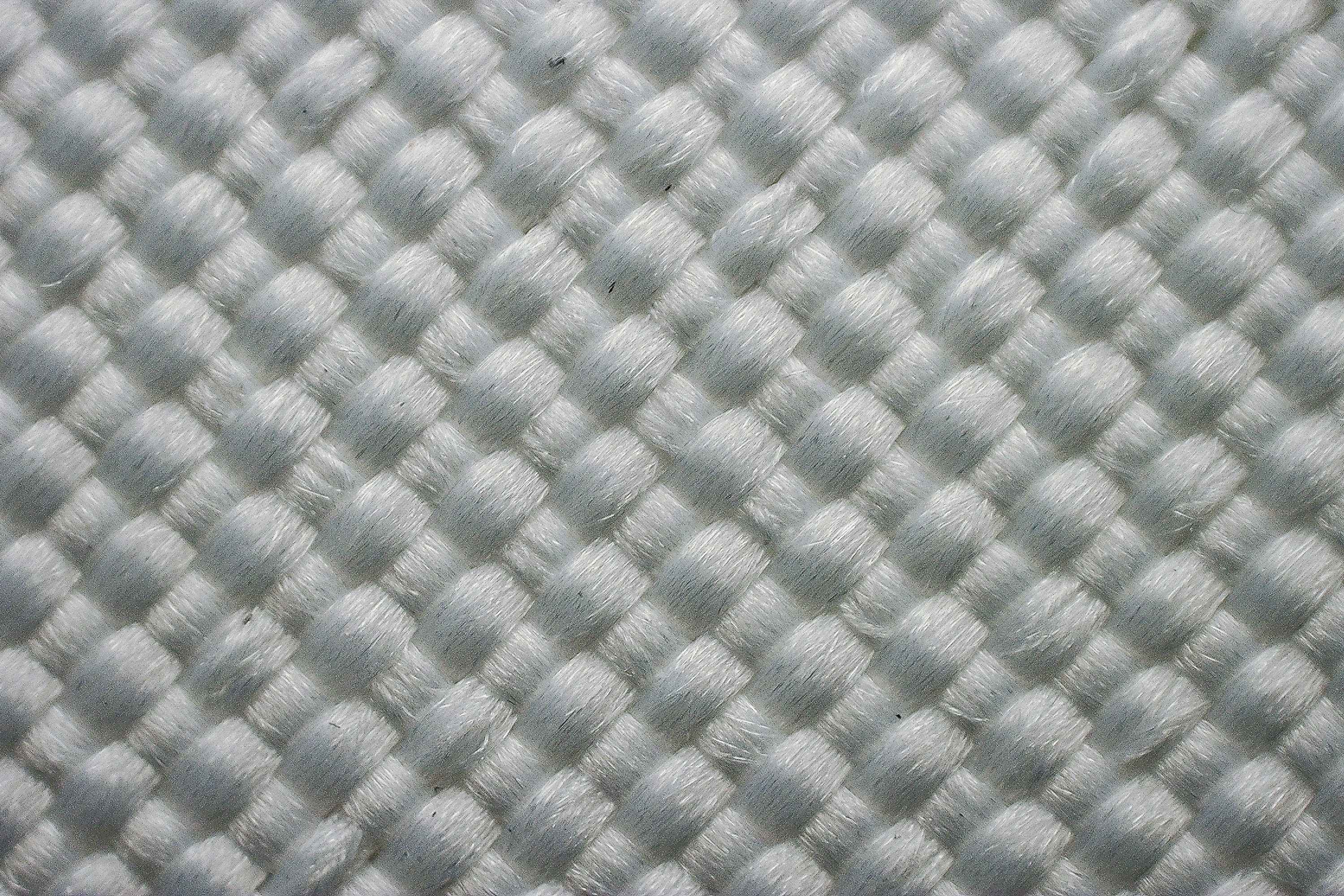
| Air Max SC | 4 |
| Average | 3 |
Stability
Lateral stability test
Even though the Air Max SC's materials don't offer the best lockdown ever, its running past can be seen and felt.
Felt because of its comfort and an upper that accommodates and adapts to the feet's movements.
And seen because of the extra eyelet at the top. Look at that! We wouldn't say running with these shoes is the best decision (actually, please have a look at our running shoes catalogue), but if you're looking for some more surefootedness, this detail is ideal!
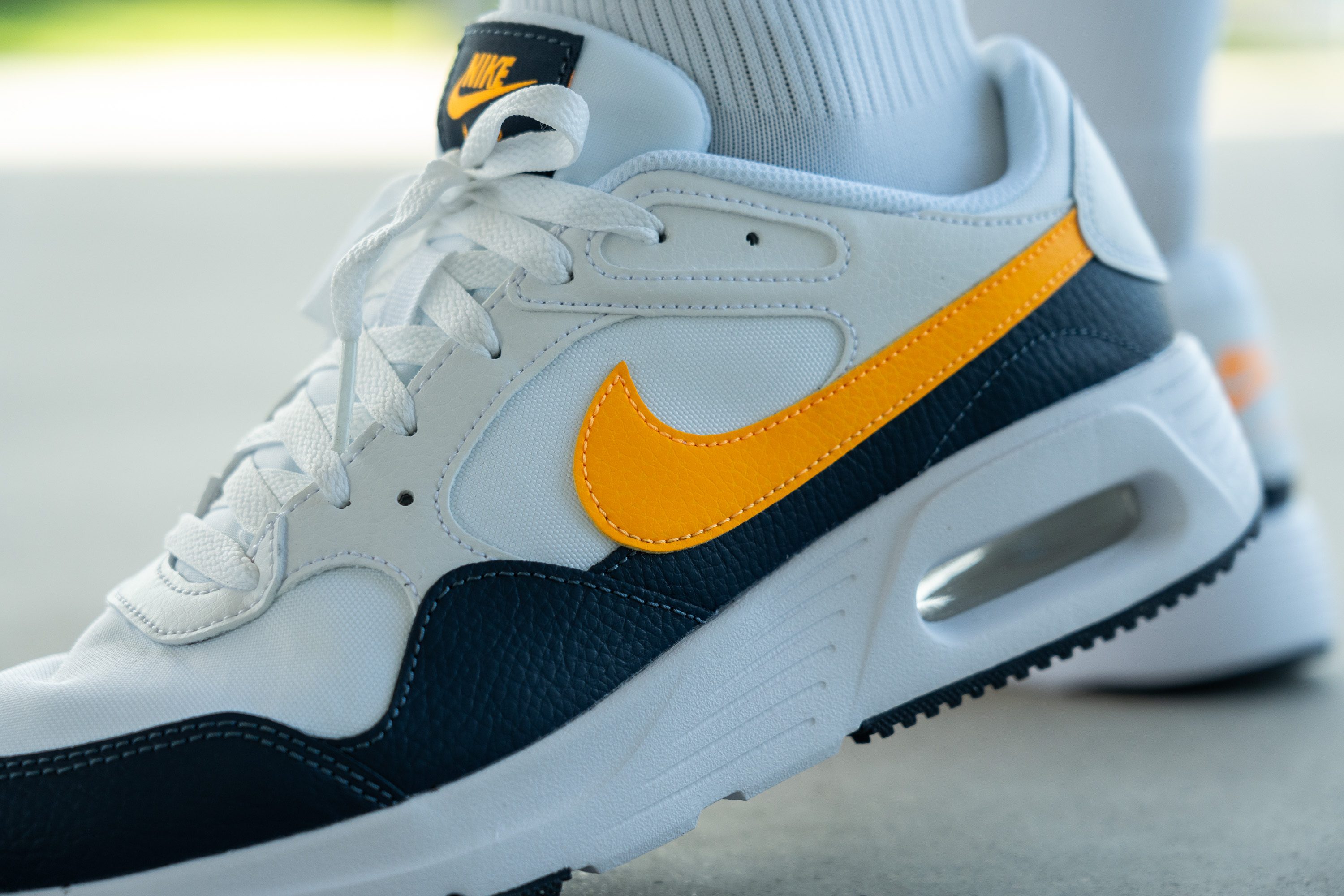
Torsional rigidity
Despite its comfortable and nice soul, the Air Max SC is a toughie when it comes to torsional rigidity.
As you can see, it wasn't easy for us to bend it, like... at all. And that's because of its chunky midsole! So we gave it a 4/5 on this test.
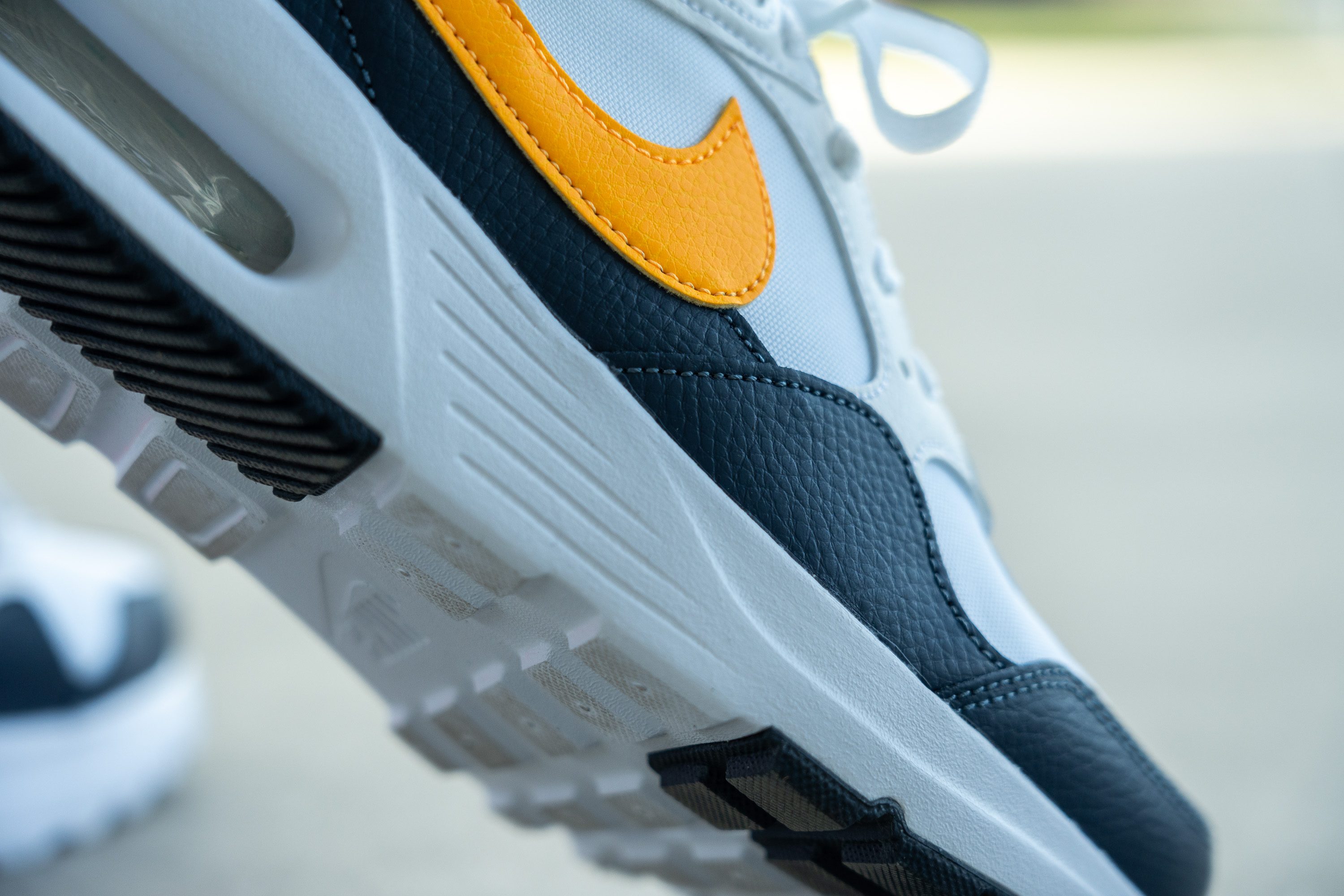
| Air Max SC | 4 |
| Average | 3.6 |
Heel counter stiffness
Even though the sides and the top part of the heel area were quite pliable, from the middle of the Achilles down, the shoe didn't bow that easily to us!
That's because of its top heel padding. In the video below, we'll show you the cut upper and its interiors. When we get to the heel, right at the end, you'll see the amount of padding at the top and the stiffer counter at the bottom.
| Air Max SC | 4 |
| Average | 3.2 |
Midsole width - forefoot
At 107.0 mm, this shoe has a slightly narrower than average midsole in the forefoot.
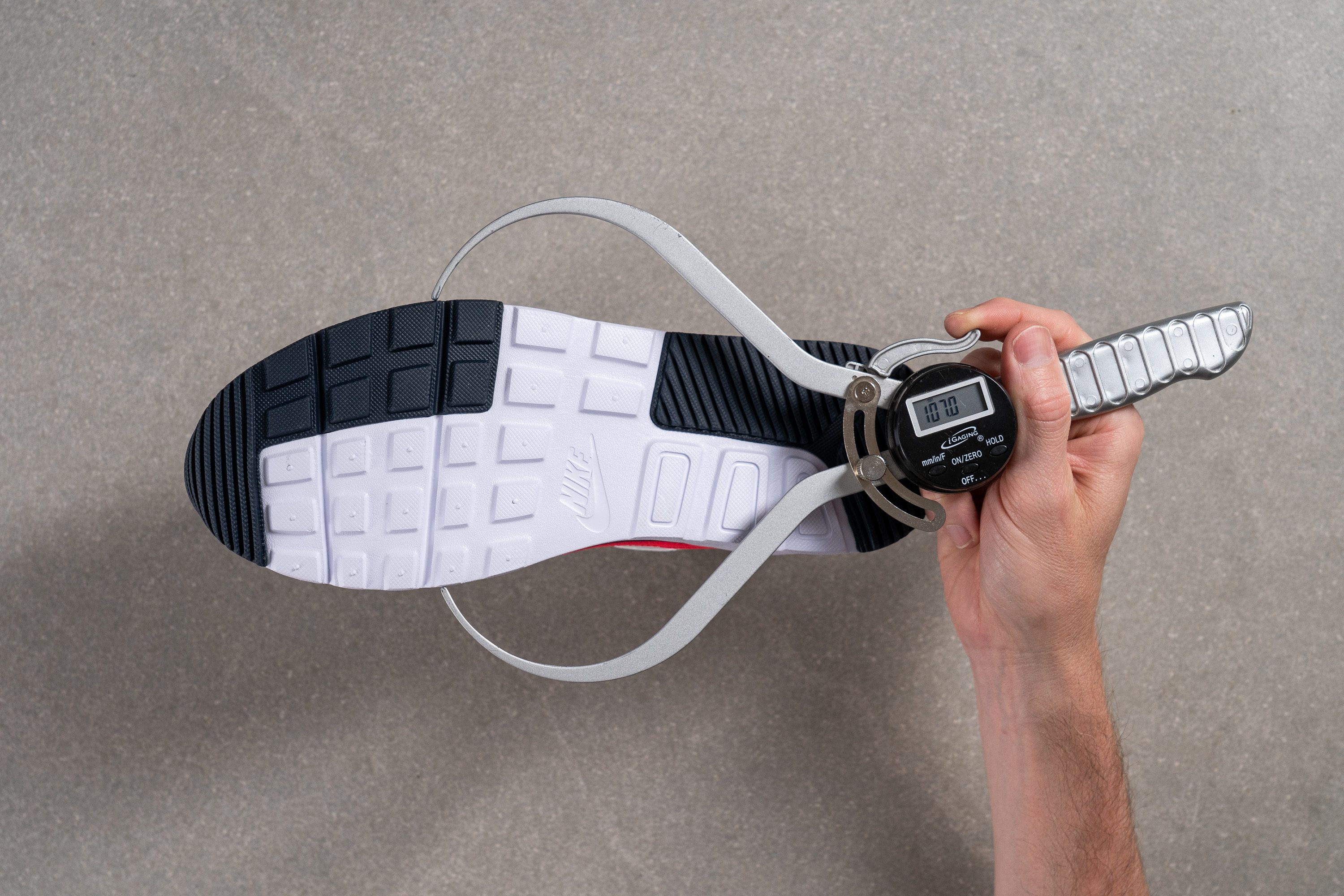
But honestly, though, we didn't even notice that until we came to our lab and grabbed the calliper.
| Air Max SC | 107.0 mm |
| Average | 108.9 mm |
Midsole width - heel
Our calliper marked that the Air Max SC's midsole width in the heel is just average, at 83.1 mm, which felt ideal on our feet.
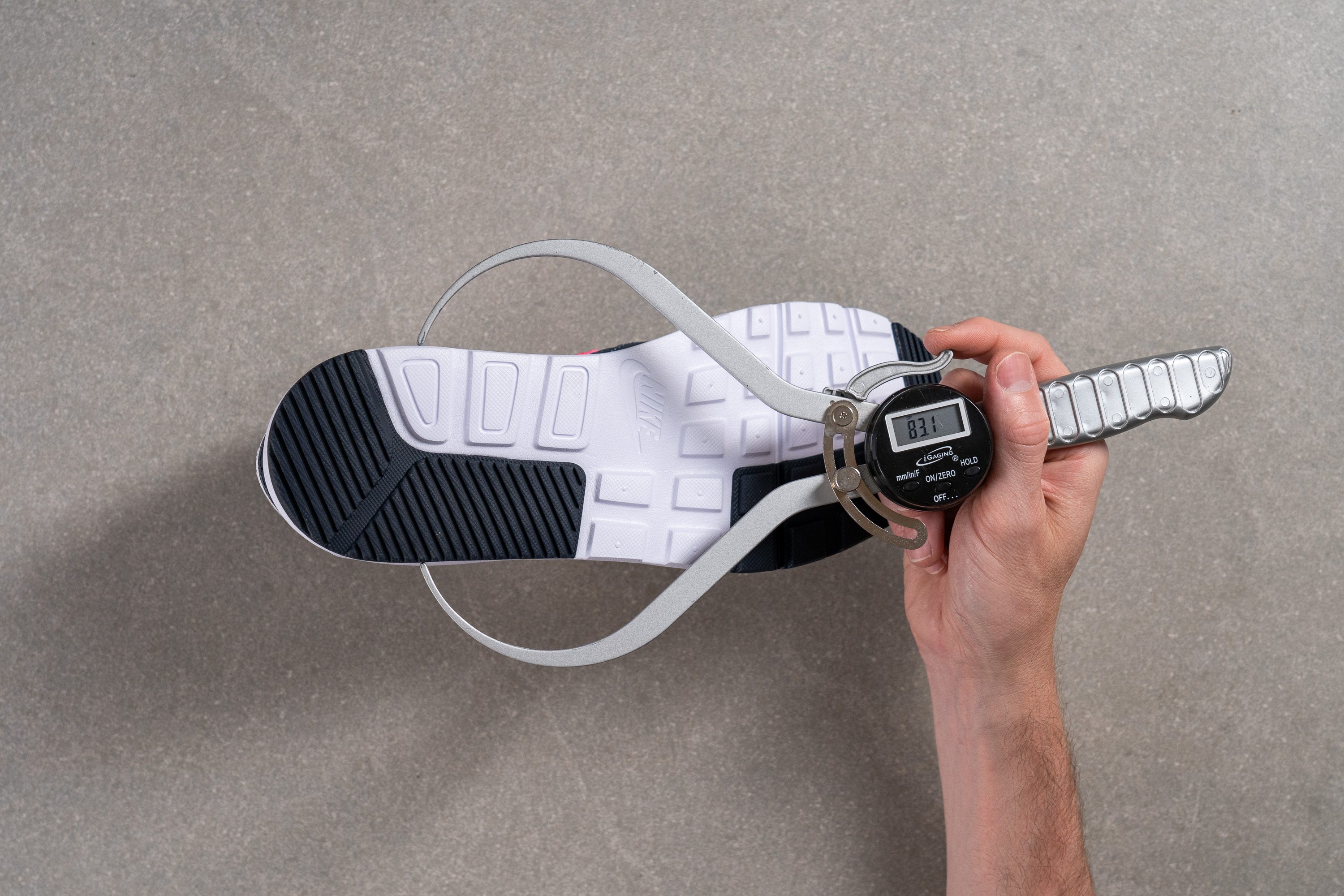
We enjoyed this shoe in every walk around town during our wear tests, from tip to heel!
| Air Max SC | 83.1 mm |
| Average | 84.0 mm |
Durability
Leather/Suede quality
The Air Max SC has different layers, so we had to put our butane torch and leather scratch awl to work!
We began burning the blue bottom part and the overall white upper material. As you can see, the latter literally melted, which means it's synthetic. On the other hand, the blue withstood the fire fairly well, so we believe it's real leather.
Then, we went for the Nike patch at the bottom. Just like a firefighter, this white piece made it through the flames, and it didn't become an extra munched chewing gum when we burnt it. Same verdict as the blue leather: authentic!
Last but not least, the Swoosh. And wow, someone got fired up! That flame and its sticky result indicate that this brand detail is synthetic.
PS: Please take into accounts that the colours we're talking about here are the ones this colorway features. They might change in different colorways of this same shoe.
Toebox durability
Now, to test this shoe's durability, we grabbed our trustworthy Dremel and started the party.
12 seconds of drilling were enough for the tool to mess up the toebox, but it wasn't able to make its way through the material. Even though we can't say the Air Max SC is as tough as an armour, we've decided to give it a fair 3/5 on our toebox durability test.

If you want to see what losing this battle against our Dremel looks like, let us show you the poor New Balance 530. You might be thinking: "Ah but there's a white underlayer that the tool couldn't get through!". No, no. That's not a layer, it's a white piece of material that we put there on purpose just to show the absolute hole!
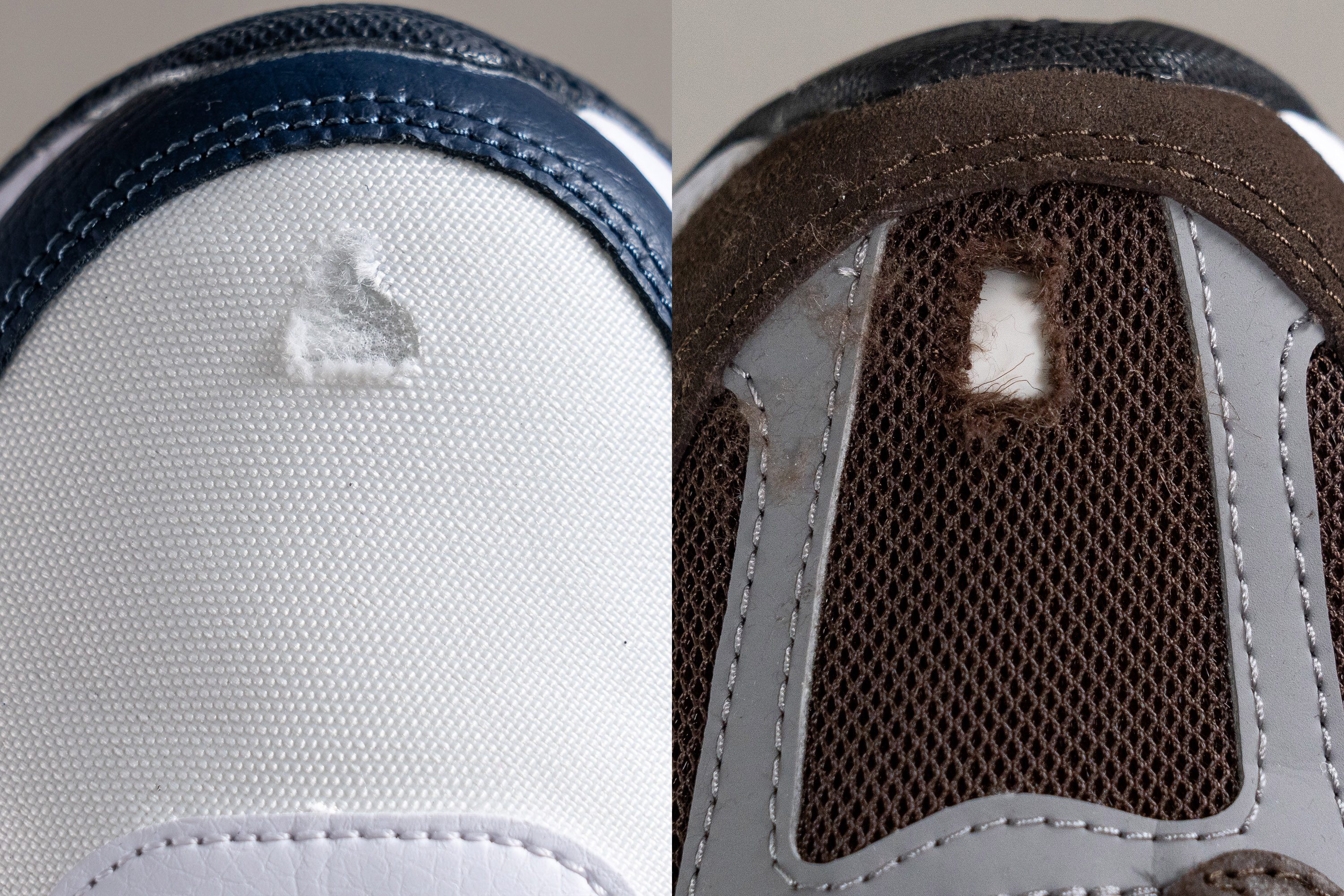
| Air Max SC | 3 |
| Average | 3.7 |
Heel padding durability
We moved the Dremel all the way to the back to see it fight the Air Max SC's heel.
We didn't see much material flying around, which is always a good sign!

Look at that, not bad at all. We were pretty happy with this shoe's resistance, so we decided to give it another 3/5 on our heel padding durability test.

Just in case you want to see what a disastrous 1/5 on this same test looks like, the New Balance 237 (on the right) is ready to show you a comparison!
| Air Max SC | 3 |
| Average | 3.2 |
Outsole hardness
This shoe's outsole is a little bit special, so we performed our hardness test in two different parts. Before we tell you about the results, let us show you what it looks like:
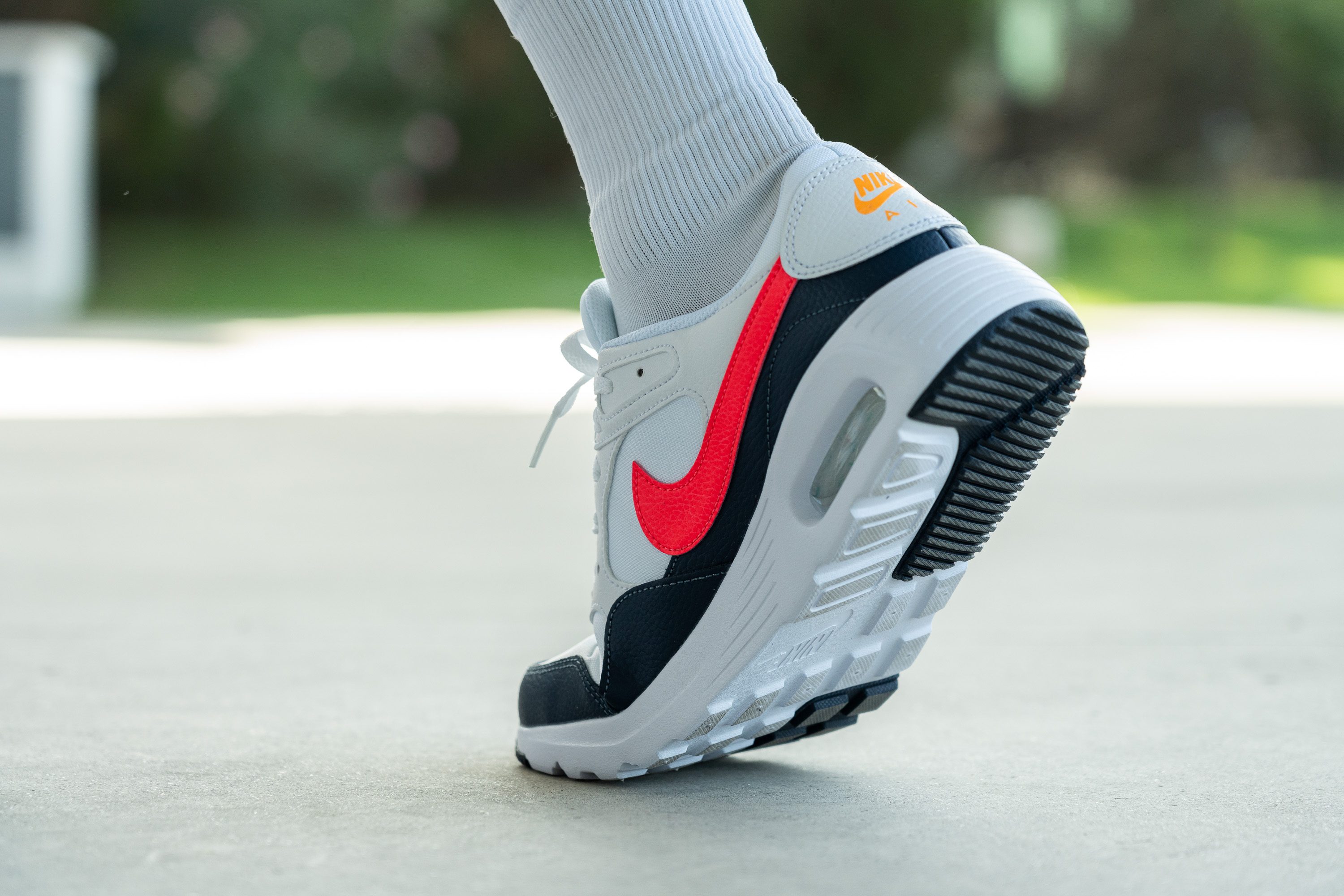
As you can see, there are two big blue rubber pieces (in this colorway), one on the outer side of the heel and one on the outer side of the forefoot. The rest of the outsole is basically an extension of the midsole's material.
We started putting our durometer in the blue layer and it returned 83.5 HC, which is pretty much average. Consequently, we believe it'll offer a great mix of durability and grip.
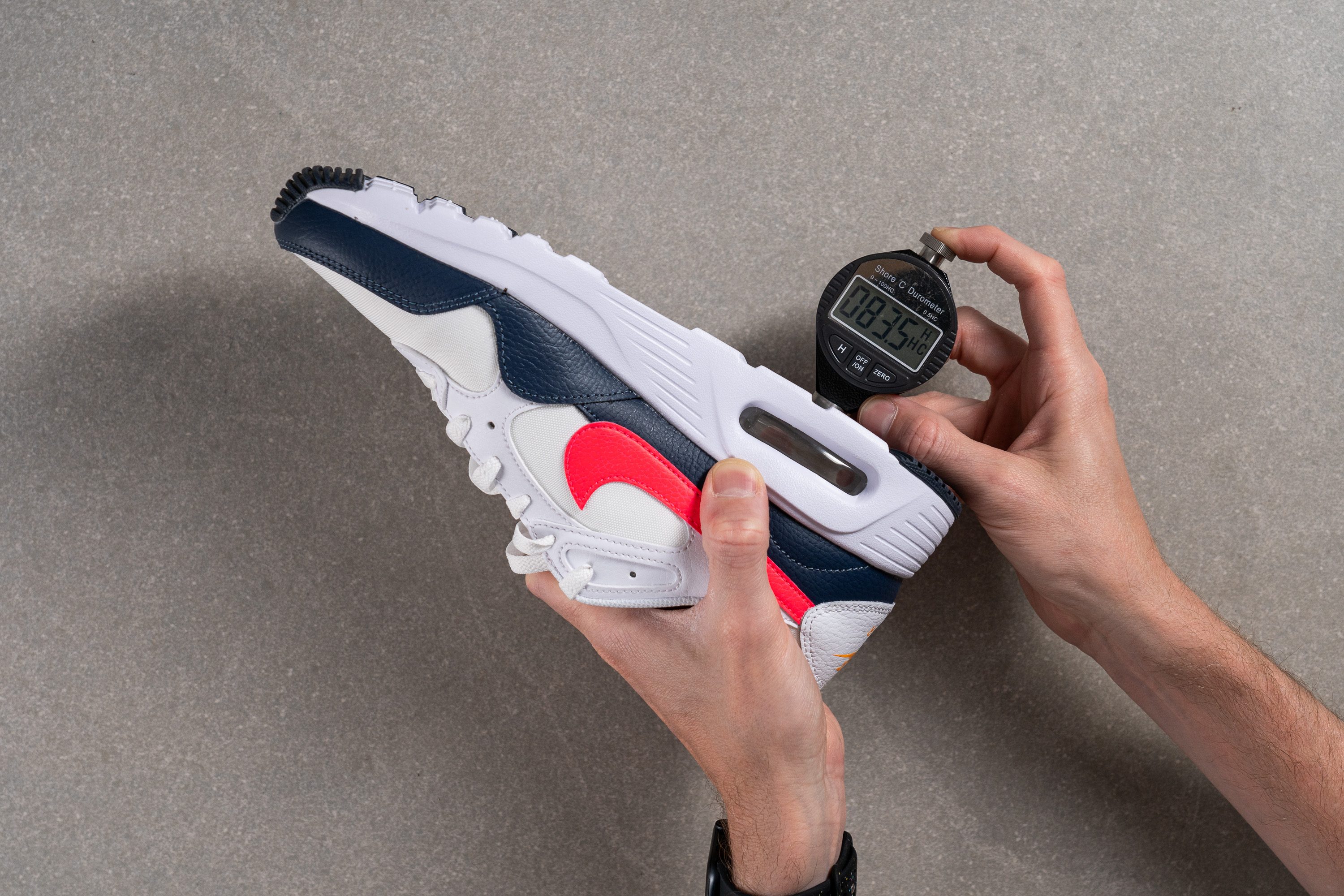
Then we went for the white part, and we can't say we were surprised when our durometer returned a score 28% lower than the previous one. At 60 HC, this material is definitely not the most durable out there!
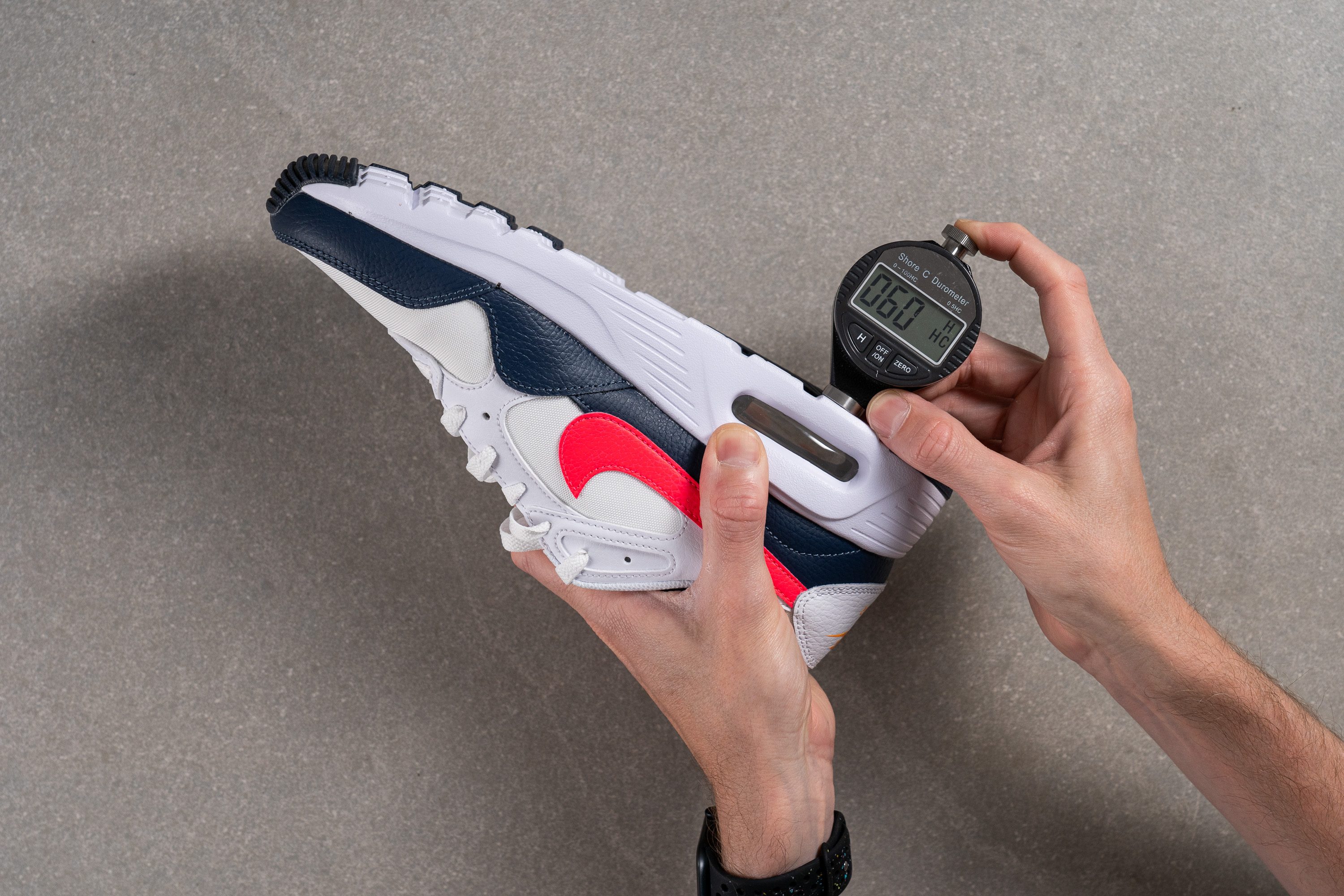
We didn't have any big issues with it during our wear tests, but we can't deny we started seeing signs of wear sooner than with many other trainers.
| Air Max SC | 83.5 HC |
| Average | 85.7 HC |
Outsole durability
Even though we put our Dremel in the most resistant part of the outsole, destroying the material didn't take it too long.
After 22 painful seconds, the Air Max SC ended up with a dent of 1.8 mm, which is way more than average. This means that the constant use of this shoe will definitely make it show signs of wear and tear sooner than later.
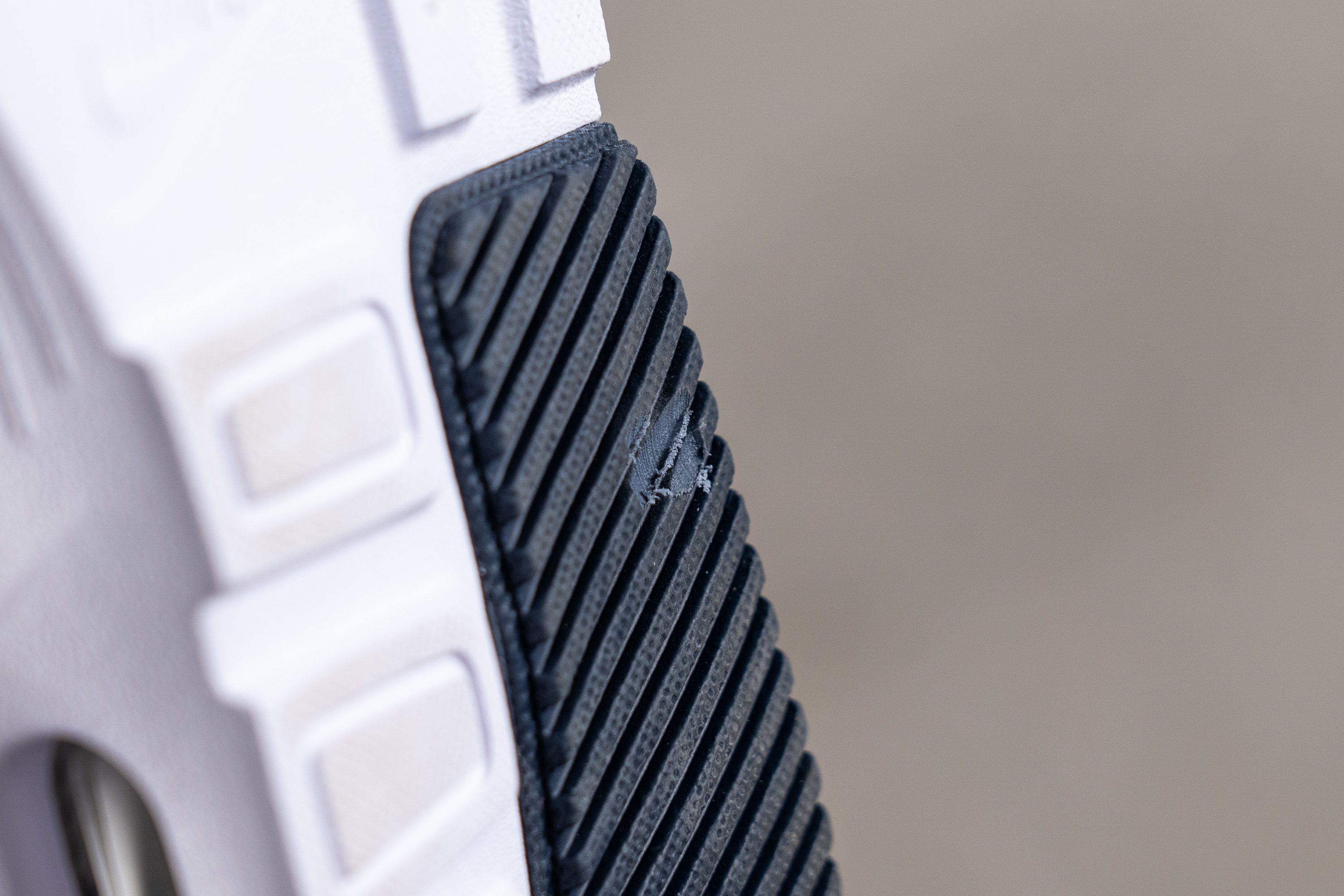
| Air Max SC | 1.8 mm |
| Average | 1.1 mm |
Outsole thickness
After the disastrous result on our outsole durability test, one would think that Nike went for a big piece of rubber to balance its low durability out.
But... it didn't.
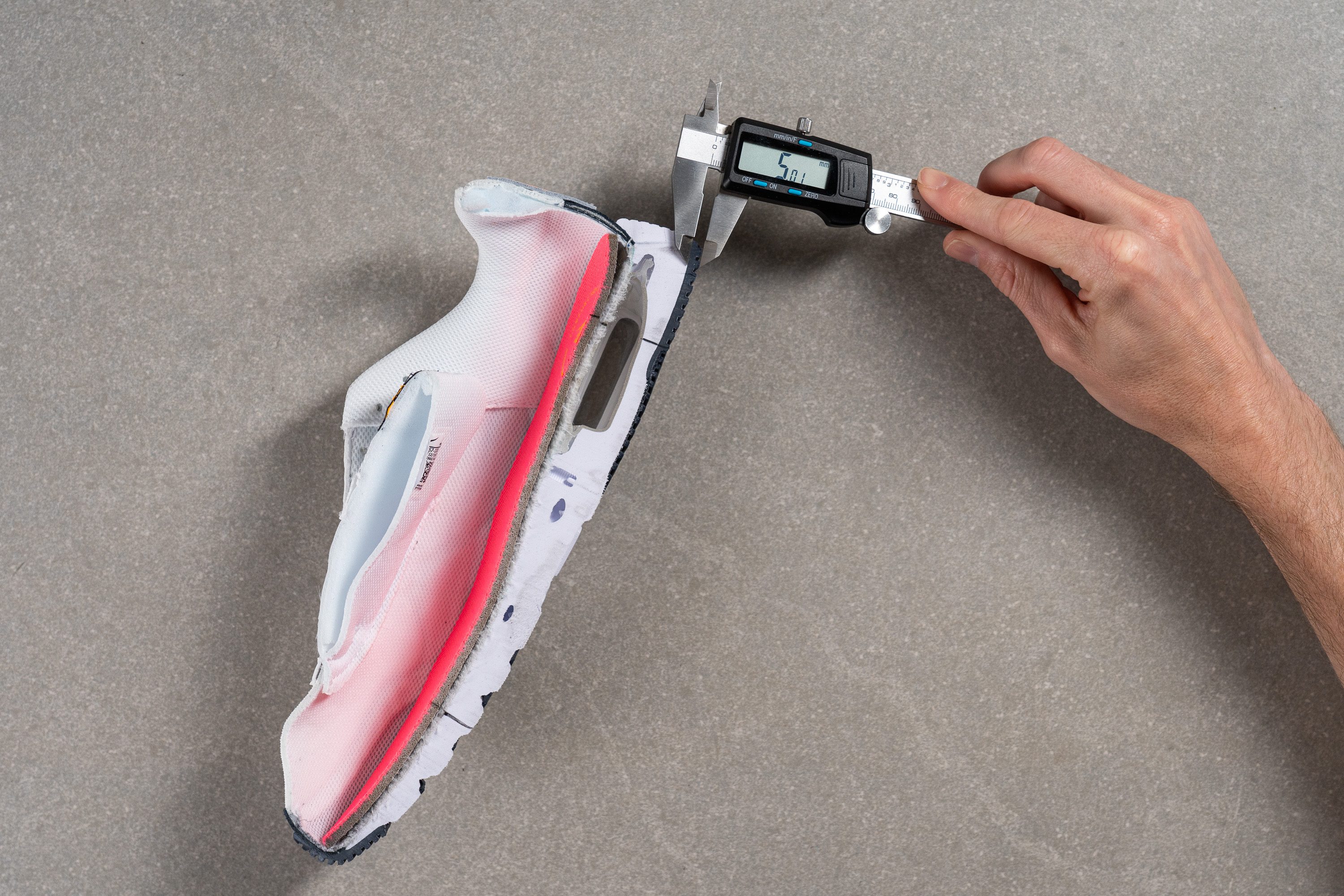
At 5.0 mm, it's lower than average. However, we can understand the brand's decision. After all, if it went for a big rubber chunk, the weight of the Air Max SC would increase, and we definitely don't want that!
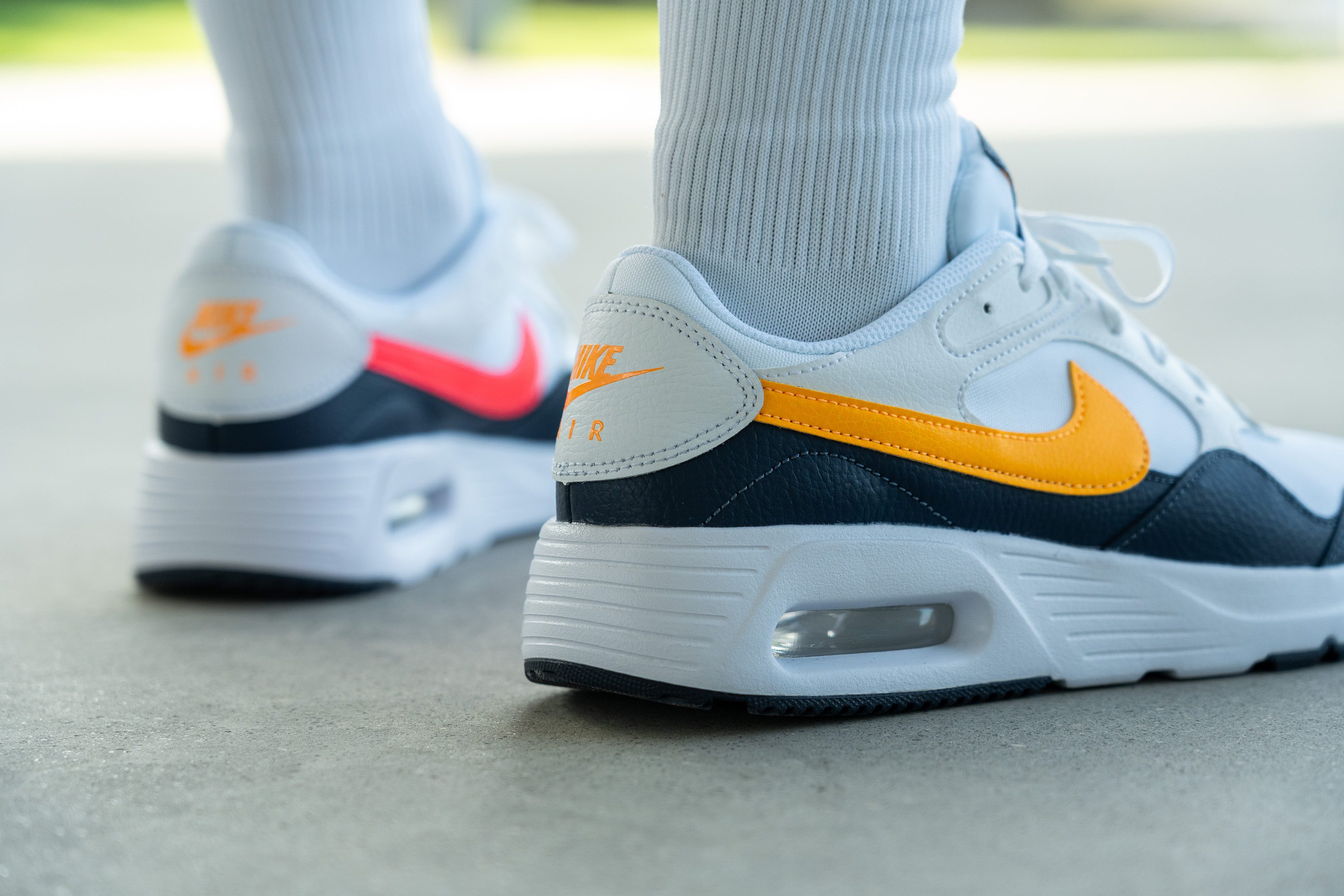
| Air Max SC | 5.0 mm |
| Average | 5.3 mm |
Misc
Insole thickness
As the Air Max SC was already pretty comfortable, we believe the brand decided not to go for the thickest insole out there, as this would most likely increase the shoe's overall weight.

At 4.1 mm, this insole is clearly thinner than average. But this didn't really make a difference for us! This sneaker's wonderful cushioning system gave us all the comfort we needed to walk for hours on end.
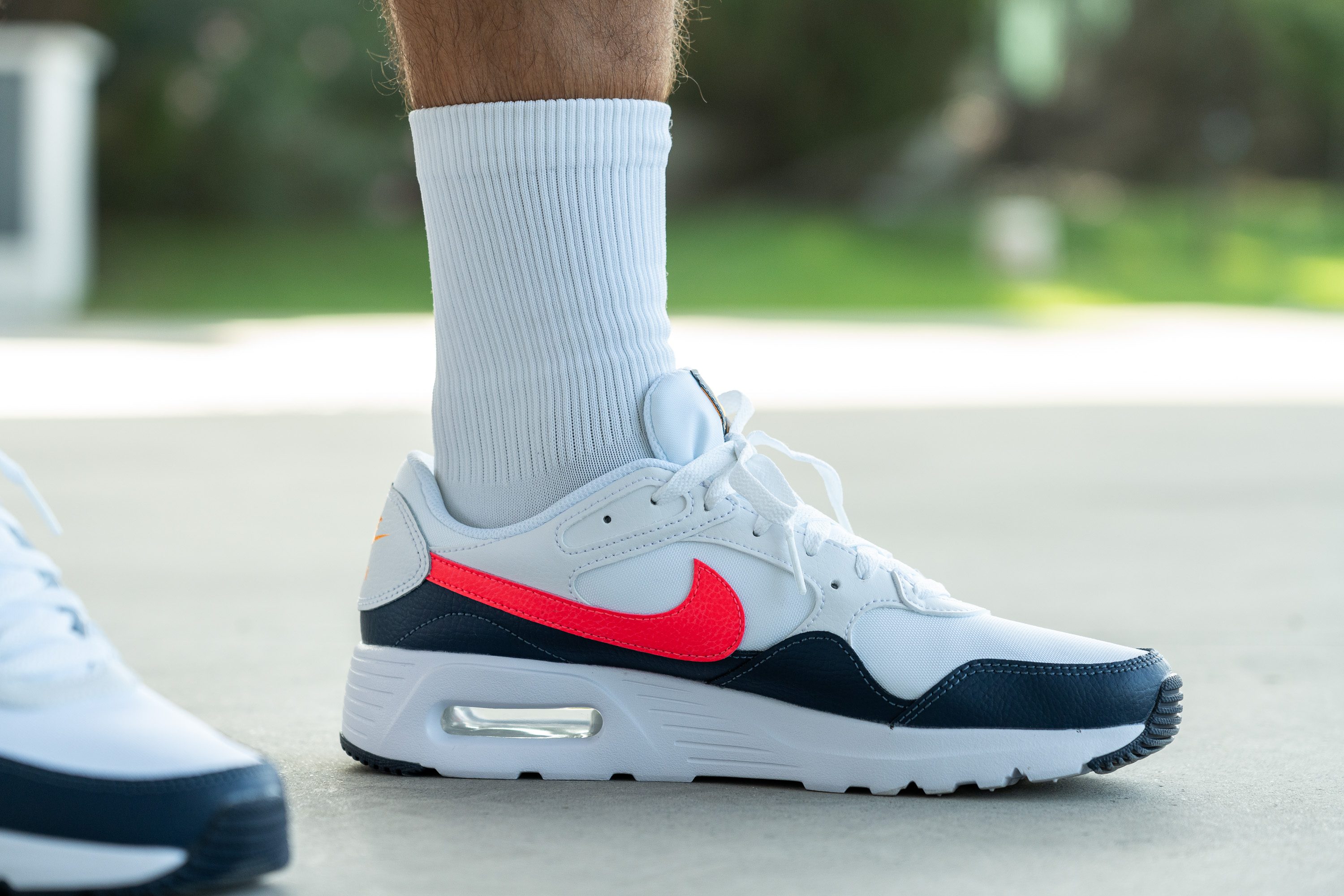
| Air Max SC | 4.1 mm |
| Average | 5.1 mm |
Removable insole
The shoe features a removable insole, which means that you can wear your own orthotics.
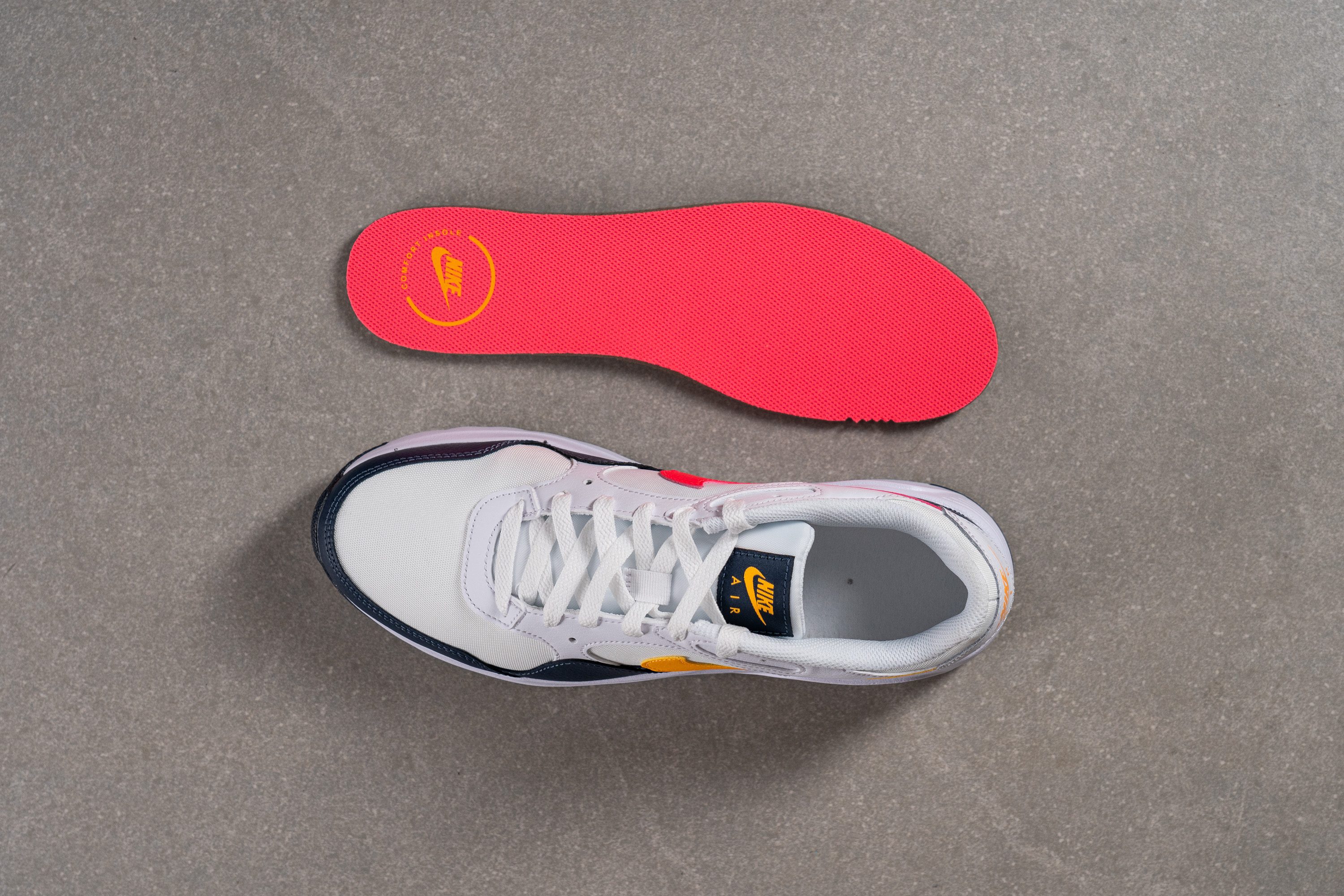
We really liked the contrasting colour of this colorway. And it's always great news that you can add the insole you need or want to use!

| Air Max SC | Yes |
Reflective elements
This is a budget shoe, so it's not like we expected it to have reflective elements at all.
When we took it to our lab we discovered that, unsurprisingly, it doesn't feature any.
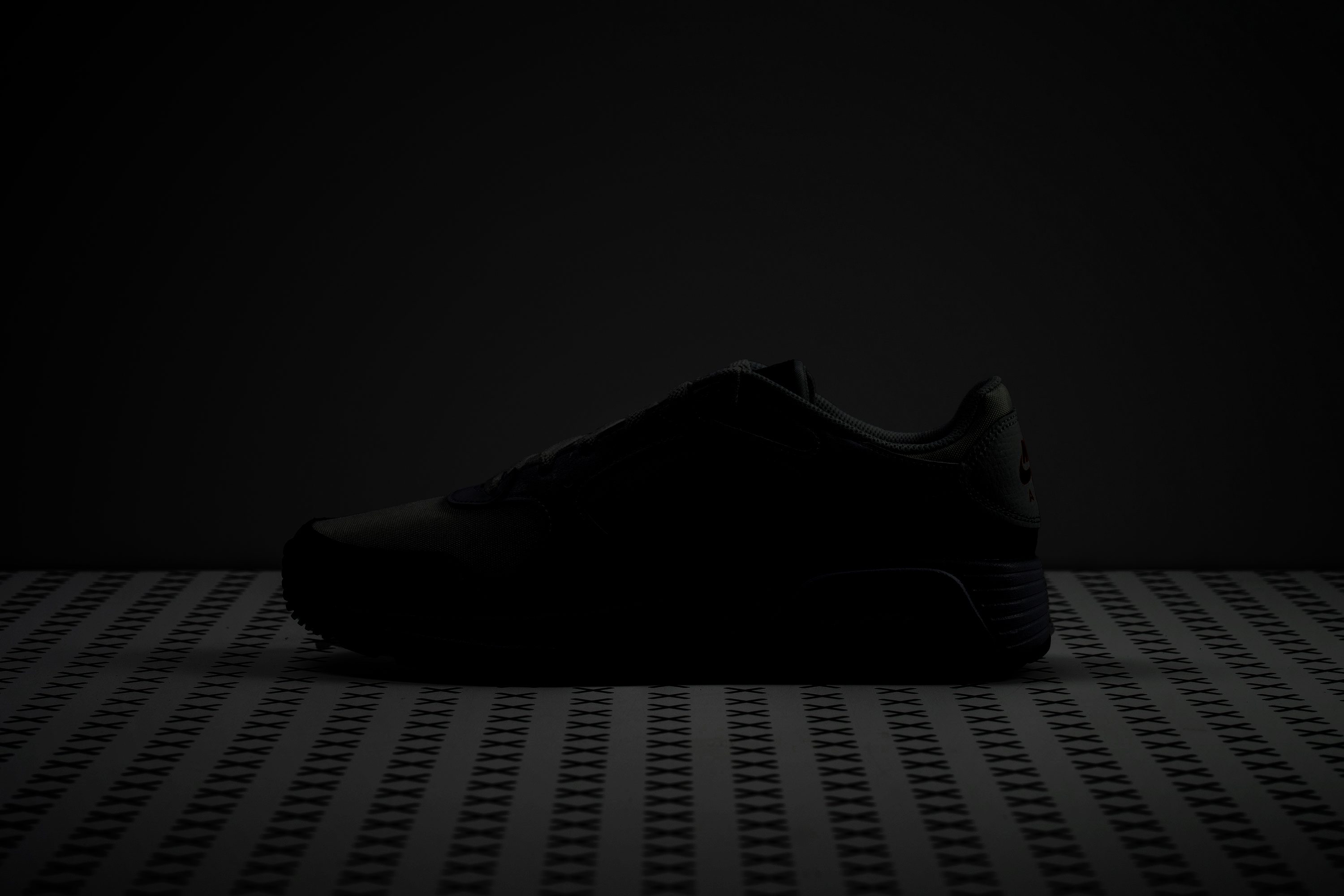
| Air Max SC | No |
Tongue padding
The 7.0 mm of padding of this shoe's tongue were perfect to keep its design lightweight and comfortable.

We didn't have to deal with any kind of lace bite, and our instep was protected enough to tighten the laces if we wanted or need to!

| Air Max SC | 7.0 mm |
| Average | 9.6 mm |
Heel tab
This Nike doesn't have any kind of heel tab, but we didn't feel like we needed it anyway.
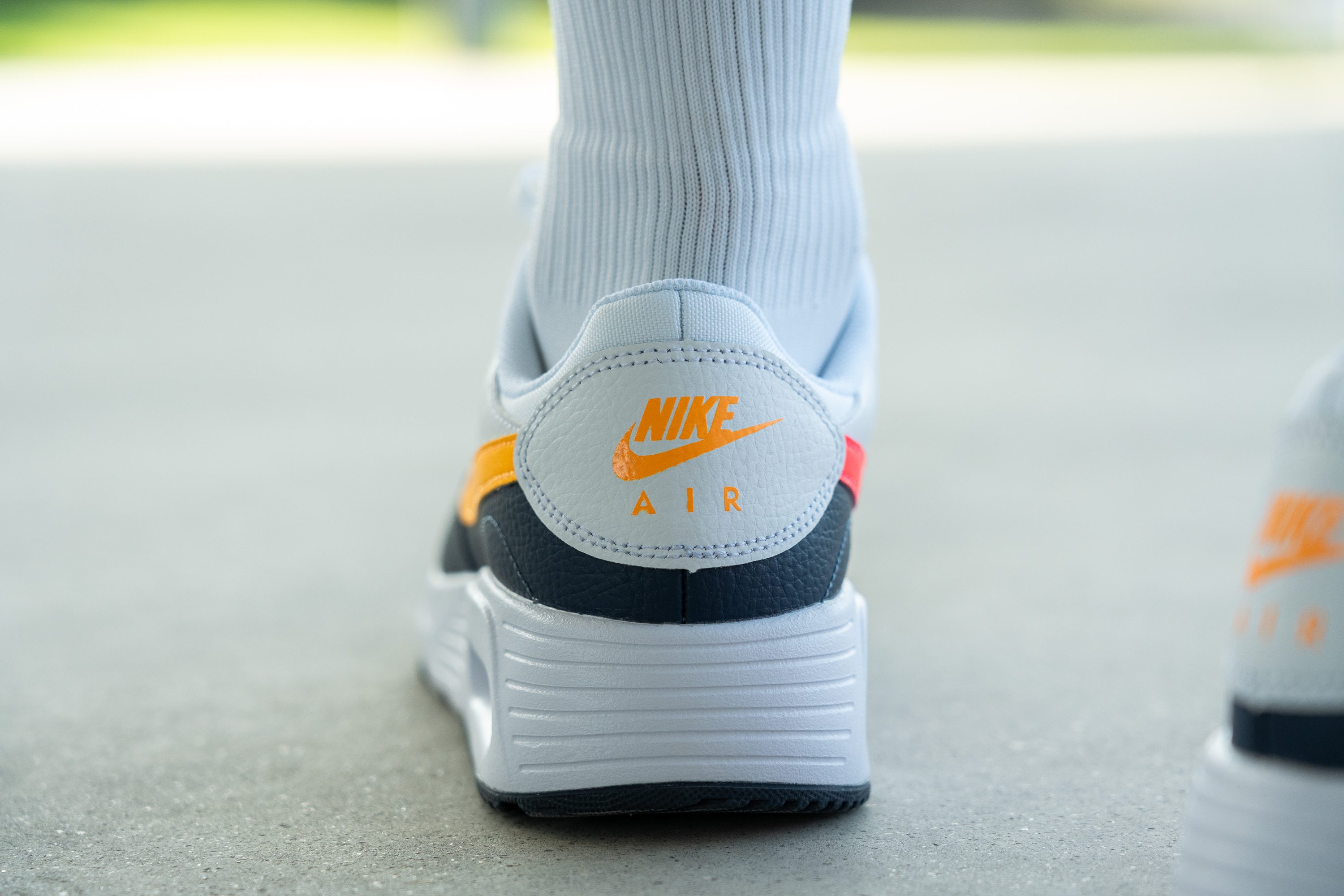
It features the brand's name and logo, as well as the name of the collection. To us, this is a nice and clean touch that just adds even more points to the Air Max SC's already impressive aesthetics.
| Air Max SC | None |

